Work samples
-
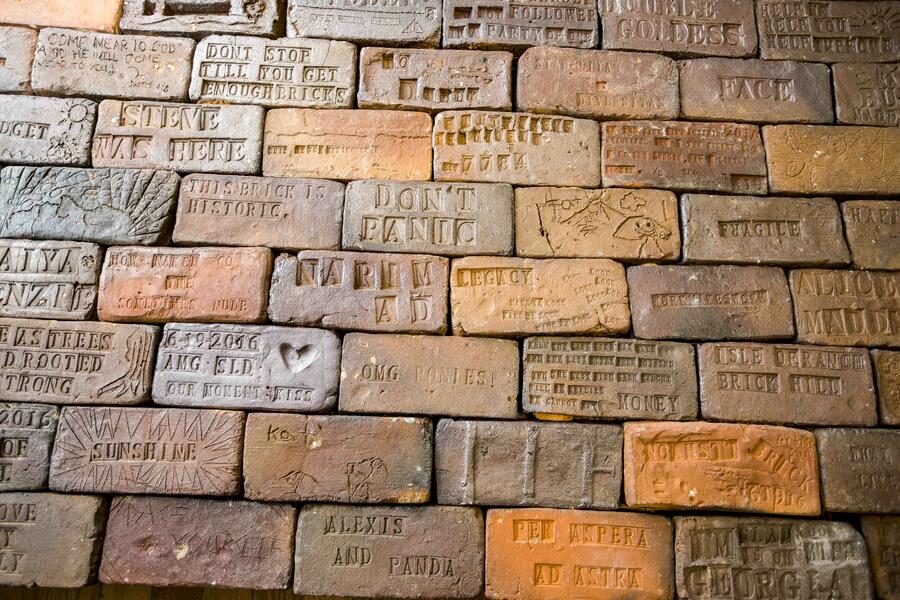 Bricks made by the Baltimore mobile Community Brick FactoryThe Baltimore Mobile Community Brick Factory Bricks Baltimore Clayworks, Project Space October 14, 2016 - November 13, 2016 This installation at Baltimore Clayworks included over 650 bricks from the first woodfiring of the bricks we made as the Baltimore Mobile Community Brick Factory. The floor configuration was installed in the project space and occupied 160 square feet. Visitors we invited to walk on the bricks to read the inscriptions. The Baltimore Mobile Community Brick Factory produces handmade bricks from local Maryland clay using historic waterstruck wooden mold methods. We invite the people of Baltimore to join us in making the bricks and personalizing them by inscribing stories and ideas about home, place, history and personal experience. The bricks made by the Baltimore Mobile Community Brick Factory, after firing, become a part of a series of public art installations. This exhibition at Baltimore Clayworks is the first installation of the bricks. The Baltimore Mobile Community Brick Factory is Marian April Glebes with Josh Copus and you. The Baltimore Mobile Community Brick Factory is made possible, in part, by a 2015 Rubys Artist Project Grant, an initiative conceived with start-up funding from the Robert W. Deutsch Foundation and is a program of the Greater Baltimore Cultural Alliance
Bricks made by the Baltimore mobile Community Brick FactoryThe Baltimore Mobile Community Brick Factory Bricks Baltimore Clayworks, Project Space October 14, 2016 - November 13, 2016 This installation at Baltimore Clayworks included over 650 bricks from the first woodfiring of the bricks we made as the Baltimore Mobile Community Brick Factory. The floor configuration was installed in the project space and occupied 160 square feet. Visitors we invited to walk on the bricks to read the inscriptions. The Baltimore Mobile Community Brick Factory produces handmade bricks from local Maryland clay using historic waterstruck wooden mold methods. We invite the people of Baltimore to join us in making the bricks and personalizing them by inscribing stories and ideas about home, place, history and personal experience. The bricks made by the Baltimore Mobile Community Brick Factory, after firing, become a part of a series of public art installations. This exhibition at Baltimore Clayworks is the first installation of the bricks. The Baltimore Mobile Community Brick Factory is Marian April Glebes with Josh Copus and you. The Baltimore Mobile Community Brick Factory is made possible, in part, by a 2015 Rubys Artist Project Grant, an initiative conceived with start-up funding from the Robert W. Deutsch Foundation and is a program of the Greater Baltimore Cultural Alliance -
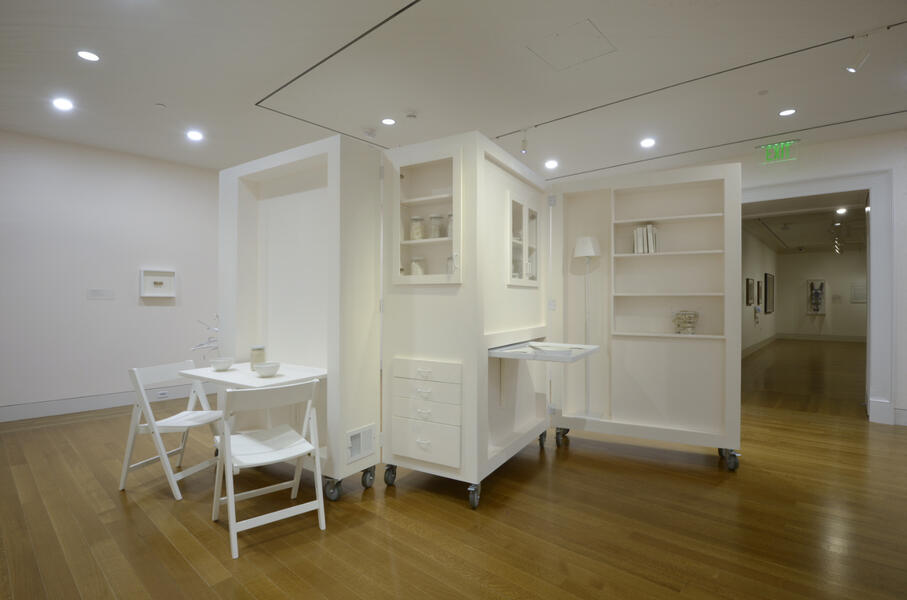 Three Sheds for Three Sites, Shed I: Home Shed (...)TITLE: Three Sheds for Three Sites, Shed I: Home Shed (One is at the Museum and Performs the Functions of Home, One is at the Salvage Material Re-Use Center and Performs the Functions of the Museum, One is at the Home of the Artist and performs the Functions of A Collection) DATE: 2015 MATERIALS: Mixed Media & Audience Participation DIMENSIONS: Dimensions Variable
Three Sheds for Three Sites, Shed I: Home Shed (...)TITLE: Three Sheds for Three Sites, Shed I: Home Shed (One is at the Museum and Performs the Functions of Home, One is at the Salvage Material Re-Use Center and Performs the Functions of the Museum, One is at the Home of the Artist and performs the Functions of A Collection) DATE: 2015 MATERIALS: Mixed Media & Audience Participation DIMENSIONS: Dimensions Variable -
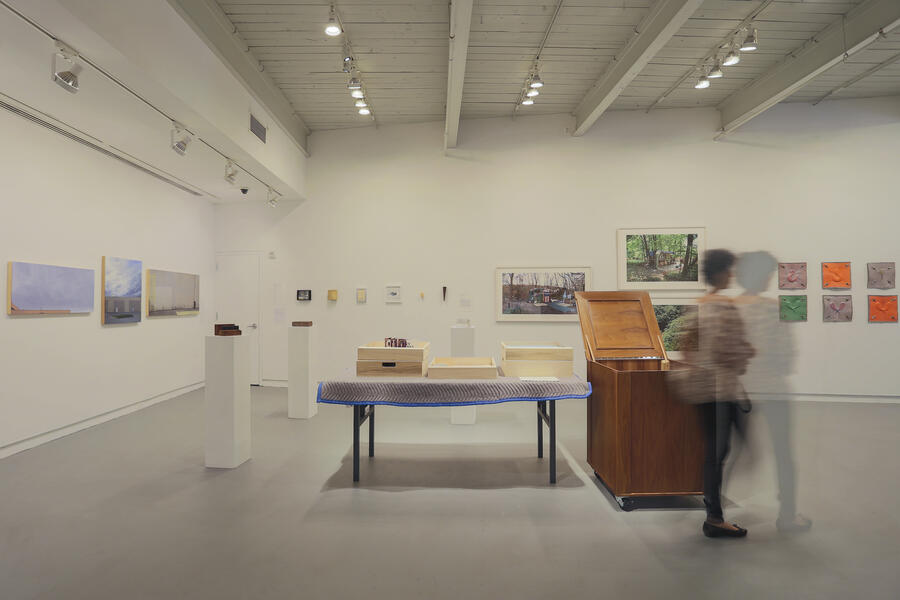 Three Sheds for Three Sites, Shed III: Collection ShedTITLE: Three Sheds for Three Sites, Shed III: Collection Shed (One is at the Museum and Performs the Functions of Home, One is at the Salvage Material Re-Use Center and Performs the Functions of the Museum, One is at the Home of the Artist and performs the Functions of A Collection) ARTIST:Marian April Glebes DATE: 2015 MATERIALS: Mixed Media & Audience Participation DIMENSIONS: Dimensions Variable
Three Sheds for Three Sites, Shed III: Collection ShedTITLE: Three Sheds for Three Sites, Shed III: Collection Shed (One is at the Museum and Performs the Functions of Home, One is at the Salvage Material Re-Use Center and Performs the Functions of the Museum, One is at the Home of the Artist and performs the Functions of A Collection) ARTIST:Marian April Glebes DATE: 2015 MATERIALS: Mixed Media & Audience Participation DIMENSIONS: Dimensions Variable
About marian april
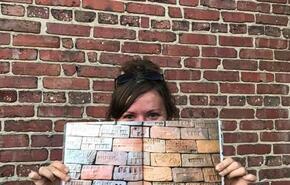
Marian April Glebes is an artist, researcher, and preservation planner based in the historic Jones Falls River Valley of Baltimore, MD. She received her BFA from the Maryland Institute College of Art (MICA) in 2004, her MFA from University of Maryland Baltimore County (UMBC) in 2009, and her MCP in City and Regional Planning and MSHP in Historic Preservation from the University of Pennsylvania’s Weitzman School of Design in 2024. For her research at UPenn, Glebes was the innaugural… more
"Three Sheds for Three Sites, Shed I: Home Shed (...)
(One is at the Museum and Performs the Functions of Home, One is at the Salvage Material Re-Use Center and Performs the Functions of the Museum, One is at the Home of the Artist and performs the Functions of A Collection)
DATE: 2015
MATERIALS: Mixed Media & Audience Participation
DIMENSIONS: Dimensions Variable
-
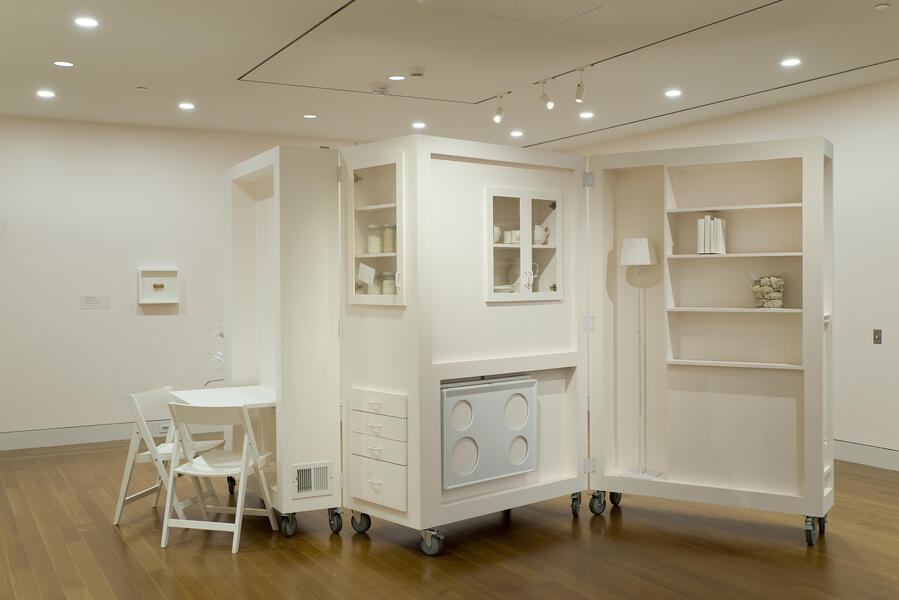 Three Sheds for Three Sites, Shed I: Home Shed (...)TITLE: Three Sheds for Three Sites, Shed I: Home Shed (One is at the Museum and Performs the Functions of Home, One is at the Salvage Material Re-Use Center and Performs the Functions of the Museum, One is at the Home of the Artist and performs the Functions of A Collection) DATE: 2015 MATERIALS: Mixed Media & Audience Participation DIMENSIONS: Dimensions Variable
Three Sheds for Three Sites, Shed I: Home Shed (...)TITLE: Three Sheds for Three Sites, Shed I: Home Shed (One is at the Museum and Performs the Functions of Home, One is at the Salvage Material Re-Use Center and Performs the Functions of the Museum, One is at the Home of the Artist and performs the Functions of A Collection) DATE: 2015 MATERIALS: Mixed Media & Audience Participation DIMENSIONS: Dimensions Variable -
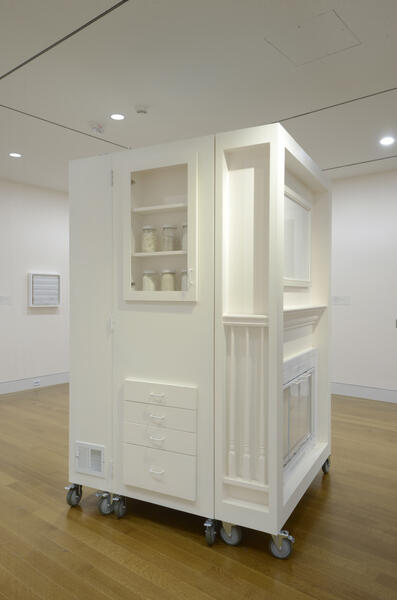 Three Sheds for Three Sites, Shed I: Home Shed (...)TITLE: Three Sheds for Three Sites, Shed I: Home Shed (One is at the Museum and Performs the Functions of Home, One is at the Salvage Material Re-Use Center and Performs the Functions of the Museum, One is at the Home of the Artist and performs the Functions of A Collection) DATE: 2015 MATERIALS: Mixed Media & Audience Participation DIMENSIONS: Dimensions Variable
Three Sheds for Three Sites, Shed I: Home Shed (...)TITLE: Three Sheds for Three Sites, Shed I: Home Shed (One is at the Museum and Performs the Functions of Home, One is at the Salvage Material Re-Use Center and Performs the Functions of the Museum, One is at the Home of the Artist and performs the Functions of A Collection) DATE: 2015 MATERIALS: Mixed Media & Audience Participation DIMENSIONS: Dimensions Variable -
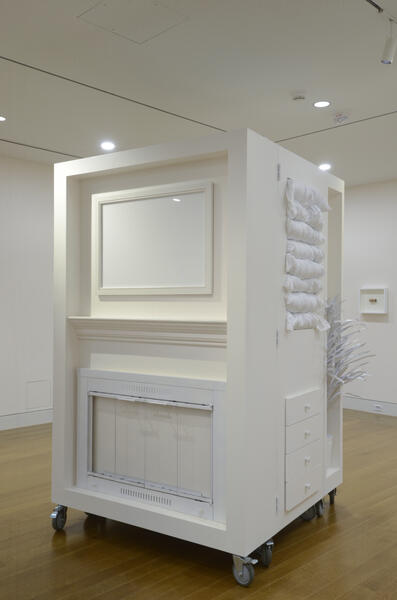 Three Sheds for Three Sites, Shed I: Home Shed (...)TITLE: Three Sheds for Three Sites, Shed I: Home Shed (One is at the Museum and Performs the Functions of Home, One is at the Salvage Material Re-Use Center and Performs the Functions of the Museum, One is at the Home of the Artist and performs the Functions of A Collection) DATE: 2015 MATERIALS: Mixed Media & Audience Participation DIMENSIONS: Dimensions Variable
Three Sheds for Three Sites, Shed I: Home Shed (...)TITLE: Three Sheds for Three Sites, Shed I: Home Shed (One is at the Museum and Performs the Functions of Home, One is at the Salvage Material Re-Use Center and Performs the Functions of the Museum, One is at the Home of the Artist and performs the Functions of A Collection) DATE: 2015 MATERIALS: Mixed Media & Audience Participation DIMENSIONS: Dimensions Variable -
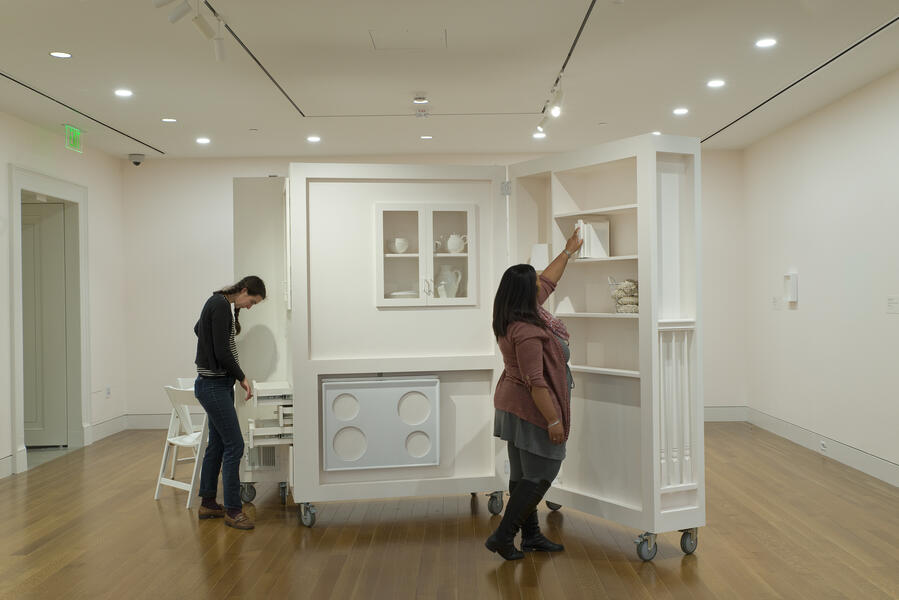 Three Sheds for Three Sites, Shed I: Home Shed (...)TITLE: Three Sheds for Three Sites, Shed I: Home Shed (One is at the Museum and Performs the Functions of Home, One is at the Salvage Material Re-Use Center and Performs the Functions of the Museum, One is at the Home of the Artist and performs the Functions of A Collection) DATE: 2015 MATERIALS: Mixed Media & Audience Participation DIMENSIONS: Dimensions Variable
Three Sheds for Three Sites, Shed I: Home Shed (...)TITLE: Three Sheds for Three Sites, Shed I: Home Shed (One is at the Museum and Performs the Functions of Home, One is at the Salvage Material Re-Use Center and Performs the Functions of the Museum, One is at the Home of the Artist and performs the Functions of A Collection) DATE: 2015 MATERIALS: Mixed Media & Audience Participation DIMENSIONS: Dimensions Variable -
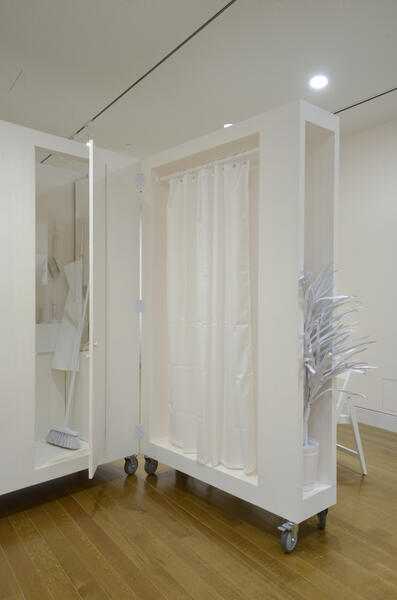 Three Sheds for Three Sites, Shed I: Home Shed (...)TITLE: Three Sheds for Three Sites, Shed I: Home Shed (One is at the Museum and Performs the Functions of Home, One is at the Salvage Material Re-Use Center and Performs the Functions of the Museum, One is at the Home of the Artist and performs the Functions of A Collection) DATE: 2015 MATERIALS: Mixed Media & Audience Participation DIMENSIONS: Dimensions Variable
Three Sheds for Three Sites, Shed I: Home Shed (...)TITLE: Three Sheds for Three Sites, Shed I: Home Shed (One is at the Museum and Performs the Functions of Home, One is at the Salvage Material Re-Use Center and Performs the Functions of the Museum, One is at the Home of the Artist and performs the Functions of A Collection) DATE: 2015 MATERIALS: Mixed Media & Audience Participation DIMENSIONS: Dimensions Variable -
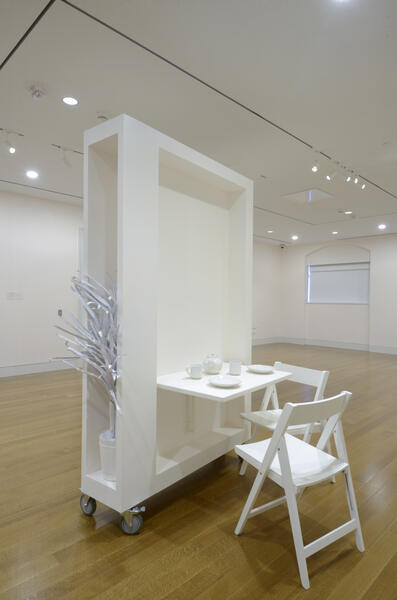 Three Sheds for Three Sites, Shed I: Home Shed (...)TITLE: Three Sheds for Three Sites, Shed I: Home Shed (One is at the Museum and Performs the Functions of Home, One is at the Salvage Material Re-Use Center and Performs the Functions of the Museum, One is at the Home of the Artist and performs the Functions of A Collection) DATE: 2015 MATERIALS: Mixed Media & Audience Participation DIMENSIONS: Dimensions Variable
Three Sheds for Three Sites, Shed I: Home Shed (...)TITLE: Three Sheds for Three Sites, Shed I: Home Shed (One is at the Museum and Performs the Functions of Home, One is at the Salvage Material Re-Use Center and Performs the Functions of the Museum, One is at the Home of the Artist and performs the Functions of A Collection) DATE: 2015 MATERIALS: Mixed Media & Audience Participation DIMENSIONS: Dimensions Variable -
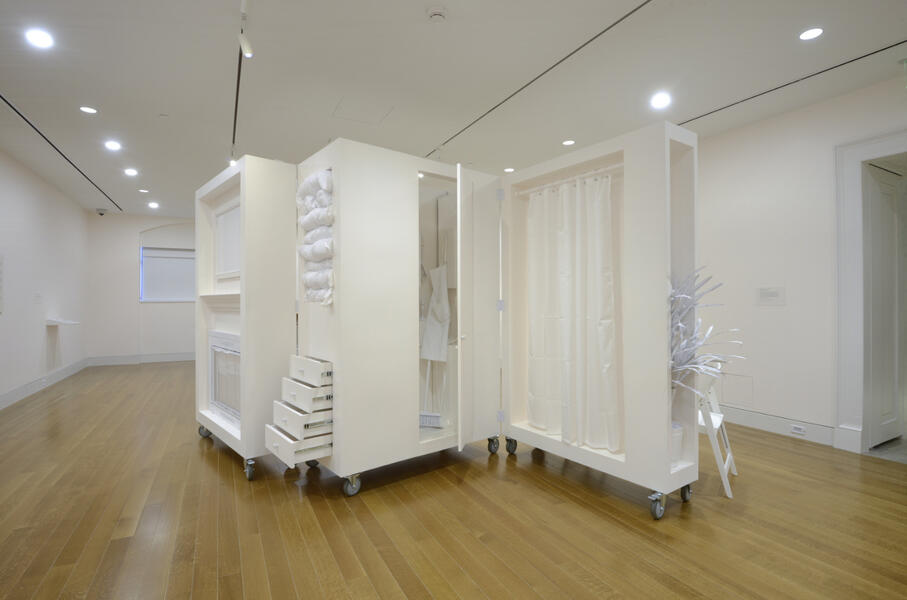 Three Sheds for Three Sites, Shed I: Home Shed (...)TITLE: Three Sheds for Three Sites, Shed I: Home Shed (One is at the Museum and Performs the Functions of Home, One is at the Salvage Material Re-Use Center and Performs the Functions of the Museum, One is at the Home of the Artist and performs the Functions of A Collection) DATE: 2015 MATERIALS: Mixed Media & Audience Participation DIMENSIONS: Dimensions Variable
Three Sheds for Three Sites, Shed I: Home Shed (...)TITLE: Three Sheds for Three Sites, Shed I: Home Shed (One is at the Museum and Performs the Functions of Home, One is at the Salvage Material Re-Use Center and Performs the Functions of the Museum, One is at the Home of the Artist and performs the Functions of A Collection) DATE: 2015 MATERIALS: Mixed Media & Audience Participation DIMENSIONS: Dimensions Variable -
 Three Sheds for Three Sites, Shed I: Home Shed (...)TITLE: Three Sheds for Three Sites, Shed I: Home Shed (One is at the Museum and Performs the Functions of Home, One is at the Salvage Material Re-Use Center and Performs the Functions of the Museum, One is at the Home of the Artist and performs the Functions of A Collection) DATE: 2015 MATERIALS: Mixed Media & Audience Participation DIMENSIONS: Dimensions Variable
Three Sheds for Three Sites, Shed I: Home Shed (...)TITLE: Three Sheds for Three Sites, Shed I: Home Shed (One is at the Museum and Performs the Functions of Home, One is at the Salvage Material Re-Use Center and Performs the Functions of the Museum, One is at the Home of the Artist and performs the Functions of A Collection) DATE: 2015 MATERIALS: Mixed Media & Audience Participation DIMENSIONS: Dimensions Variable -
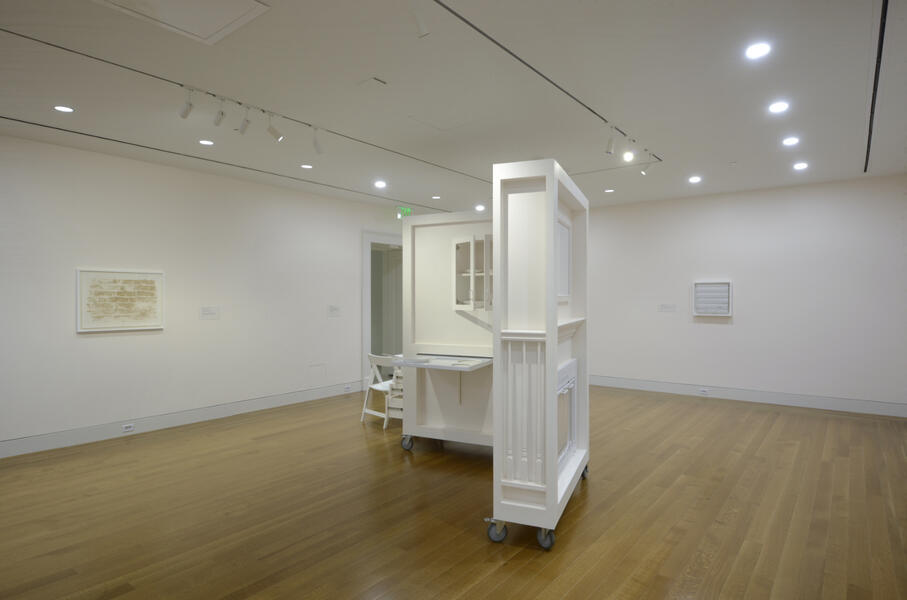 Three Sheds for Three Sites, Shed I: Home Shed (...)TITLE: Three Sheds for Three Sites, Shed I: Home Shed (One is at the Museum and Performs the Functions of Home, One is at the Salvage Material Re-Use Center and Performs the Functions of the Museum, One is at the Home of the Artist and performs the Functions of A Collection) DATE: 2015 MATERIALS: Mixed Media & Audience Participation DIMENSIONS: Dimensions Variable
Three Sheds for Three Sites, Shed I: Home Shed (...)TITLE: Three Sheds for Three Sites, Shed I: Home Shed (One is at the Museum and Performs the Functions of Home, One is at the Salvage Material Re-Use Center and Performs the Functions of the Museum, One is at the Home of the Artist and performs the Functions of A Collection) DATE: 2015 MATERIALS: Mixed Media & Audience Participation DIMENSIONS: Dimensions Variable -
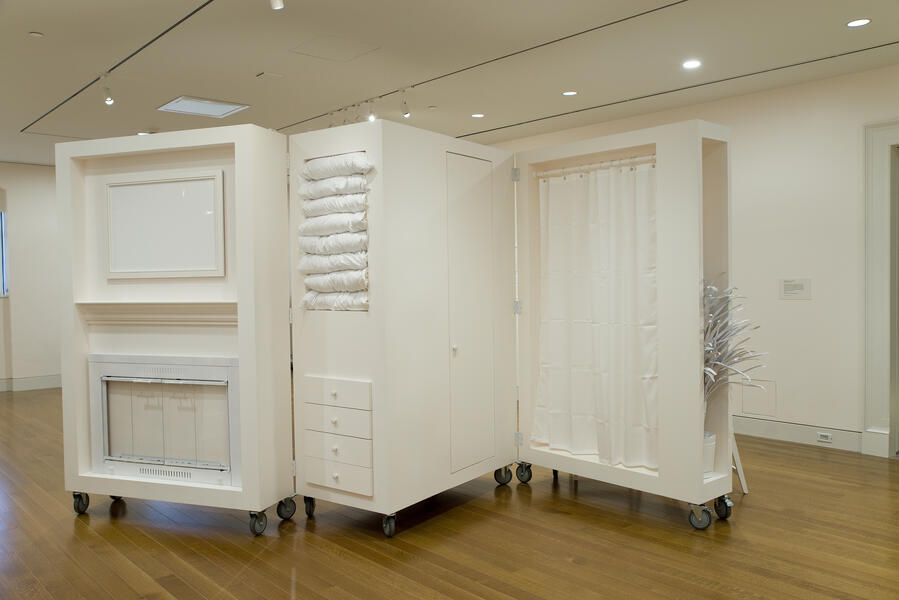 Three Sheds for Three Sites, Shed I: Home Shed (...)TITLE: Three Sheds for Three Sites, Shed I: Home Shed (One is at the Museum and Performs the Functions of Home, One is at the Salvage Material Re-Use Center and Performs the Functions of the Museum, One is at the Home of the Artist and performs the Functions of A Collection) DATE: 2015 MATERIALS: Mixed Media & Audience Participation DIMENSIONS: Dimensions Variable
Three Sheds for Three Sites, Shed I: Home Shed (...)TITLE: Three Sheds for Three Sites, Shed I: Home Shed (One is at the Museum and Performs the Functions of Home, One is at the Salvage Material Re-Use Center and Performs the Functions of the Museum, One is at the Home of the Artist and performs the Functions of A Collection) DATE: 2015 MATERIALS: Mixed Media & Audience Participation DIMENSIONS: Dimensions Variable
from the series "Material Studies"
-
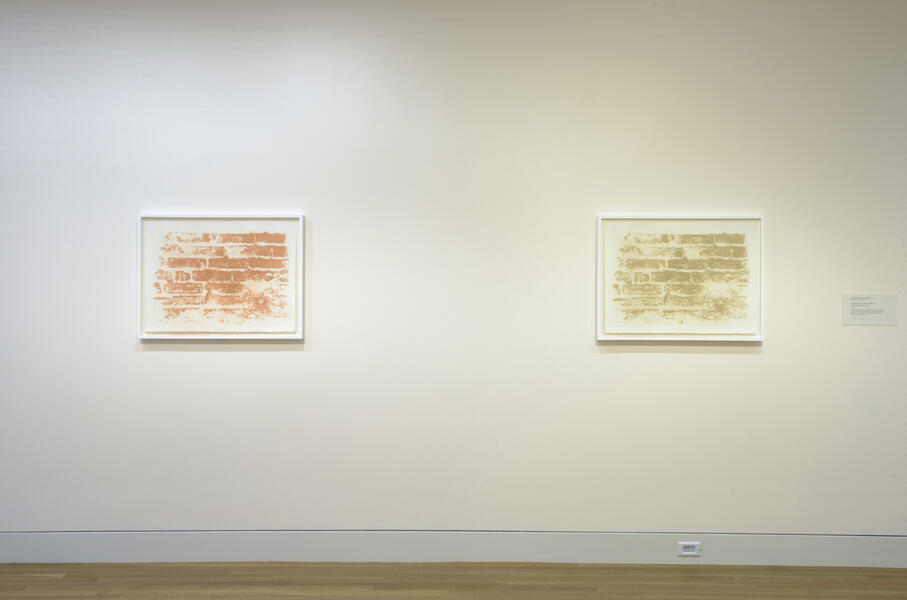 Untitled Study in Brick and Mortar (Foundation Turned Sand)DATE: 2015 MATERIALS: Brick and mortar dust collected from 10 locations in the artist's basement that evidence failure of the foundation, Silkscreen on Arches 88, Edition of 10 DIMENSIONS: 22"x30" unframed, 25 1/4"x 35 1/2" framed
Untitled Study in Brick and Mortar (Foundation Turned Sand)DATE: 2015 MATERIALS: Brick and mortar dust collected from 10 locations in the artist's basement that evidence failure of the foundation, Silkscreen on Arches 88, Edition of 10 DIMENSIONS: 22"x30" unframed, 25 1/4"x 35 1/2" framed -
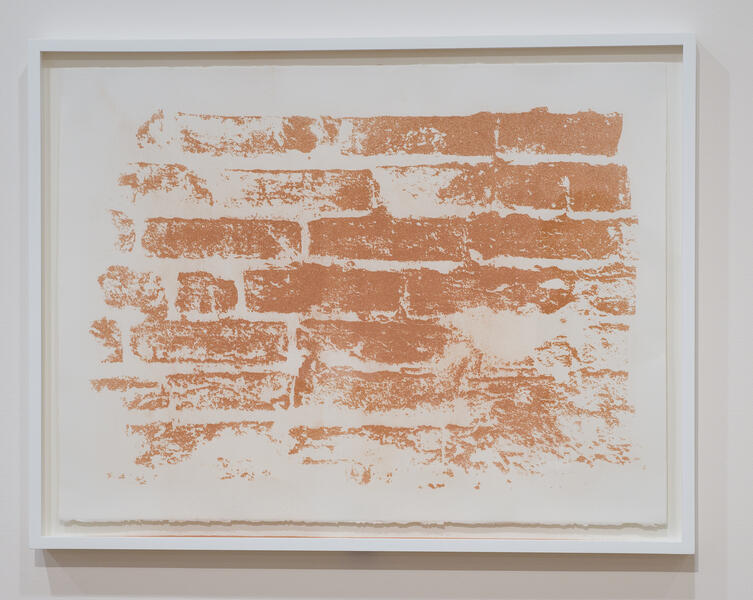 Untitled Study in Brick and Mortar (Foundation Turned Sand)DATE: 2015 MATERIALS: Brick and mortar dust collected from 10 locations in the artist's basement that evidence failure of the foundation, Silkscreen on Arches 88, Edition of 10 DIMENSIONS: 22"x30" unframed, 25 1/4"x 35 1/2" framed
Untitled Study in Brick and Mortar (Foundation Turned Sand)DATE: 2015 MATERIALS: Brick and mortar dust collected from 10 locations in the artist's basement that evidence failure of the foundation, Silkscreen on Arches 88, Edition of 10 DIMENSIONS: 22"x30" unframed, 25 1/4"x 35 1/2" framed -
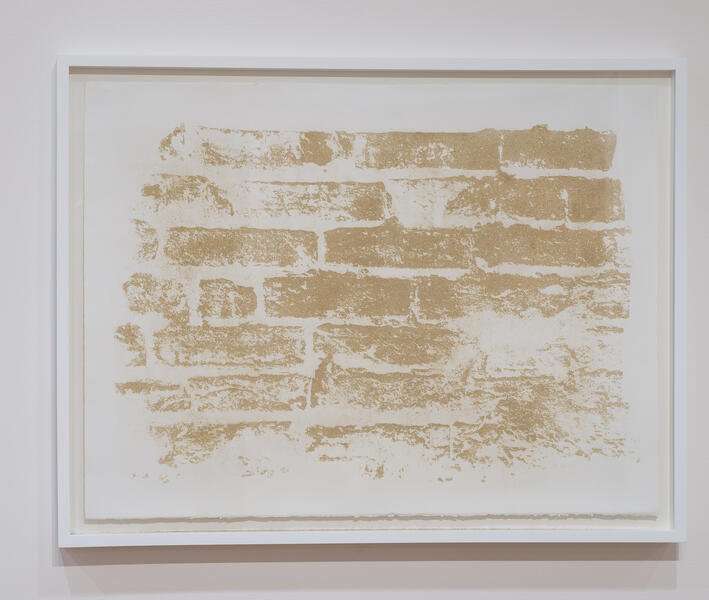 Untitled Study in Brick and Mortar (Foundation Turned Sand)DATE: 2015 MATERIALS: Brick and mortar dust collected from 10 locations in the artist's basement that evidence failure of the foundation, Silkscreen on Arches 88, Edition of 10 DIMENSIONS: 22"x30" unframed, 25 1/4"x 35 1/2" framed
Untitled Study in Brick and Mortar (Foundation Turned Sand)DATE: 2015 MATERIALS: Brick and mortar dust collected from 10 locations in the artist's basement that evidence failure of the foundation, Silkscreen on Arches 88, Edition of 10 DIMENSIONS: 22"x30" unframed, 25 1/4"x 35 1/2" framed -
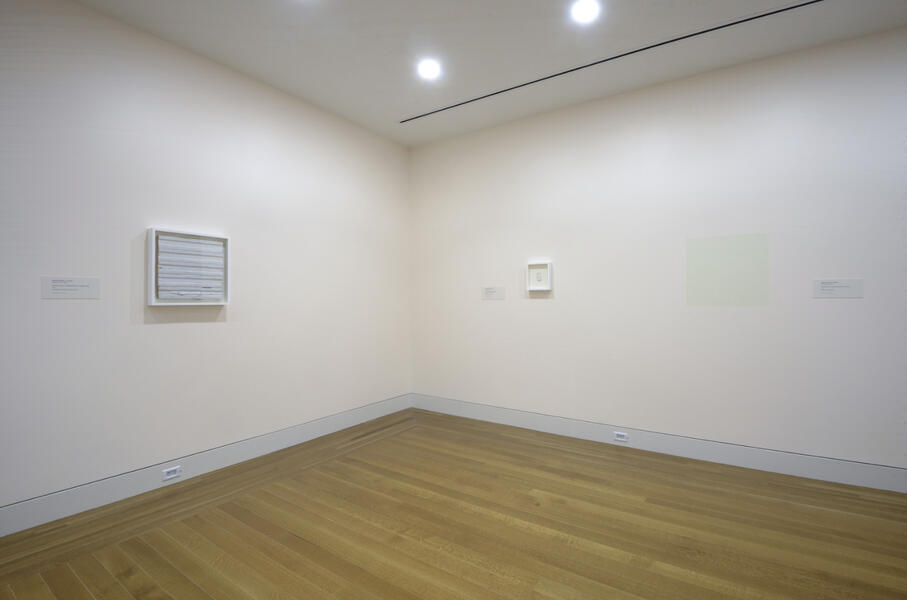 Untitled Studies in Lead-Based Paint, Installation View"Untitled Studies in Lead-Based Paint" Installation View, from the series "Material Studies"exhibited at the Baltimore Museum of Art, 2015-2016
Untitled Studies in Lead-Based Paint, Installation View"Untitled Studies in Lead-Based Paint" Installation View, from the series "Material Studies"exhibited at the Baltimore Museum of Art, 2015-2016 -
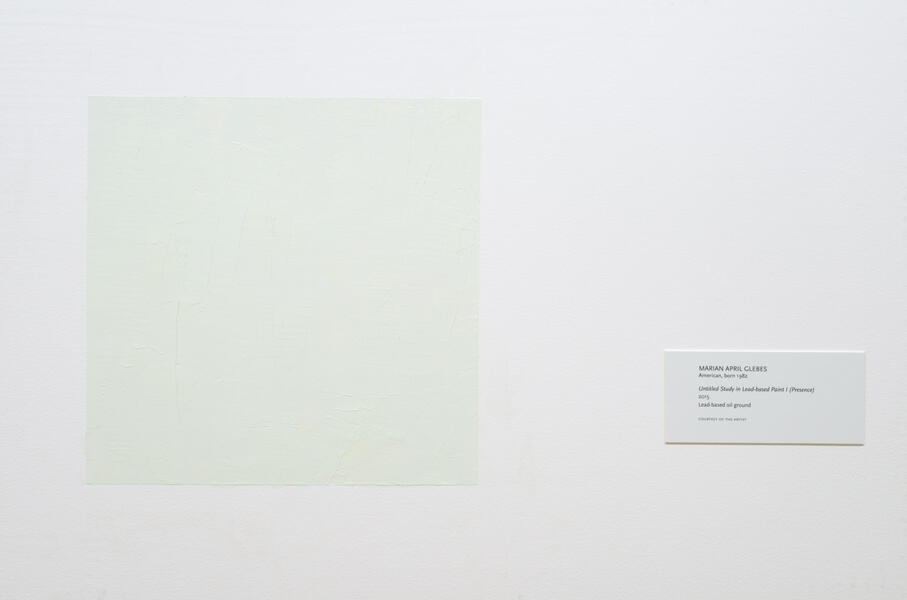 Untitled Study in Lead-based Paint I (Presence)DATE: 2015 MATERIALS: Lead-based Oil Ground, applied directly to gallery wall DIMENSIONS: 1' 9" x 1' 9" - Dimensions variable to 1% of painted wall surface
Untitled Study in Lead-based Paint I (Presence)DATE: 2015 MATERIALS: Lead-based Oil Ground, applied directly to gallery wall DIMENSIONS: 1' 9" x 1' 9" - Dimensions variable to 1% of painted wall surface -
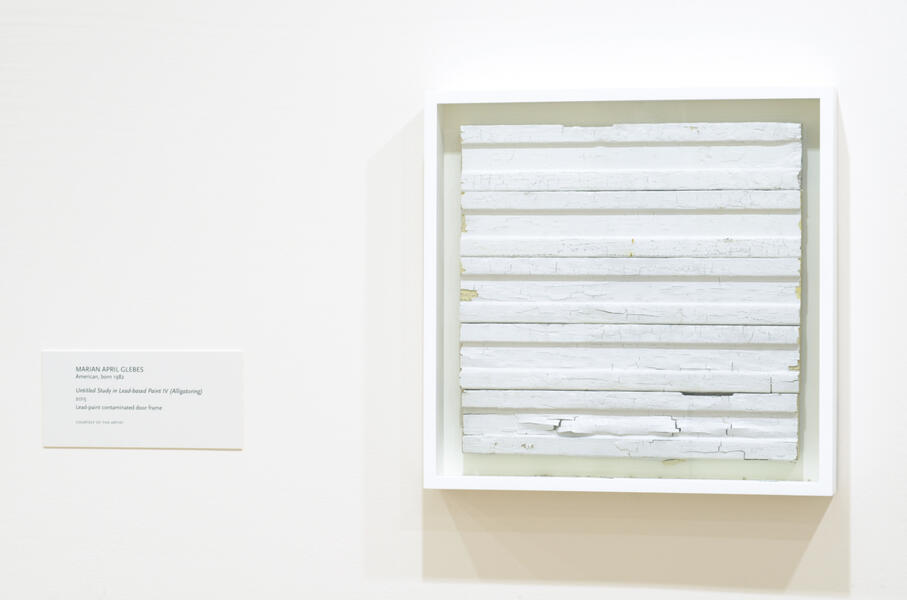 Untitled Study in Lead-based Paint IV (Alligatoring)DATE: 2015 MATERIALS: Lead-paint Contaminated Door Frame DIMENSIONS: 16 3/4"x16 1/4" unframed, 22" x 22" framed
Untitled Study in Lead-based Paint IV (Alligatoring)DATE: 2015 MATERIALS: Lead-paint Contaminated Door Frame DIMENSIONS: 16 3/4"x16 1/4" unframed, 22" x 22" framed -
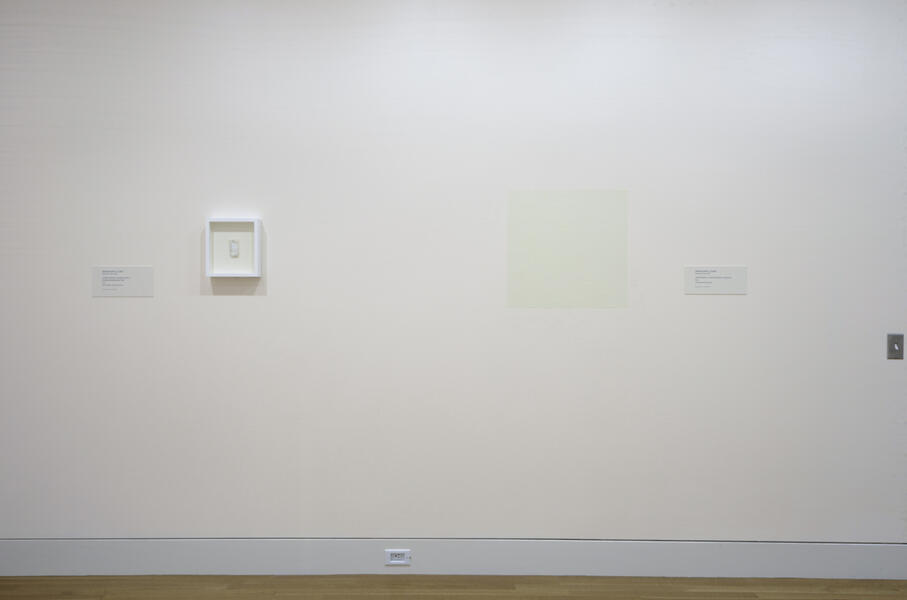 Untitled Study in Lead-based Paint II (Positive Risk Reduction Test) & Untitled Study in Lead-based Paint I (Presence)INSTALLATION VIEW: Untitled Study in Lead-based Paint II (Positive Risk Reduction Test) & Untitled Study in Lead-based Paint I (Presence)
Untitled Study in Lead-based Paint II (Positive Risk Reduction Test) & Untitled Study in Lead-based Paint I (Presence)INSTALLATION VIEW: Untitled Study in Lead-based Paint II (Positive Risk Reduction Test) & Untitled Study in Lead-based Paint I (Presence) -
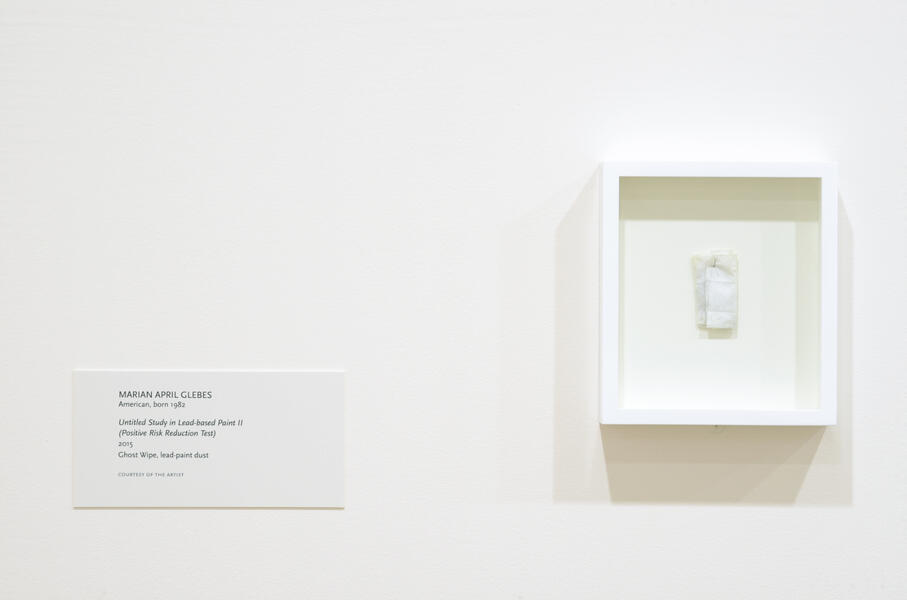 Untitled Study in Lead-based Paint II (Positive Risk Reduction Test)DATE: 2015 MATERIALS: Ghost Wipe, Lead-paint dust DIMENSIONS: 3"x3" unframed, 12"x12" framed
Untitled Study in Lead-based Paint II (Positive Risk Reduction Test)DATE: 2015 MATERIALS: Ghost Wipe, Lead-paint dust DIMENSIONS: 3"x3" unframed, 12"x12" framed -
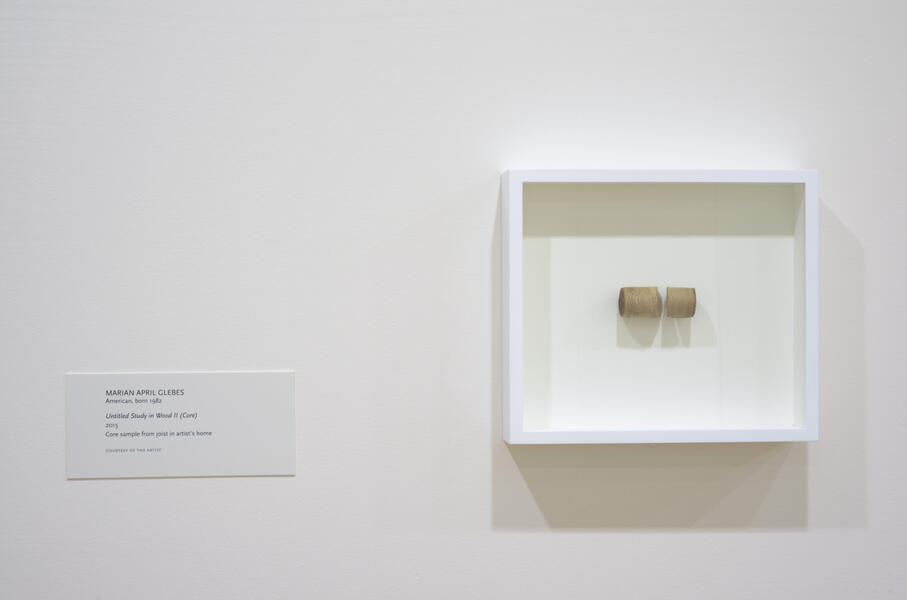 Untitled Study in Wood II (Core)DATE: 2015 MATERIALS: Core Sample from Joists in Artist's Home DIMENSIONS: 1 1/2" "x3" unframed, 15"x15" framed
Untitled Study in Wood II (Core)DATE: 2015 MATERIALS: Core Sample from Joists in Artist's Home DIMENSIONS: 1 1/2" "x3" unframed, 15"x15" framed -
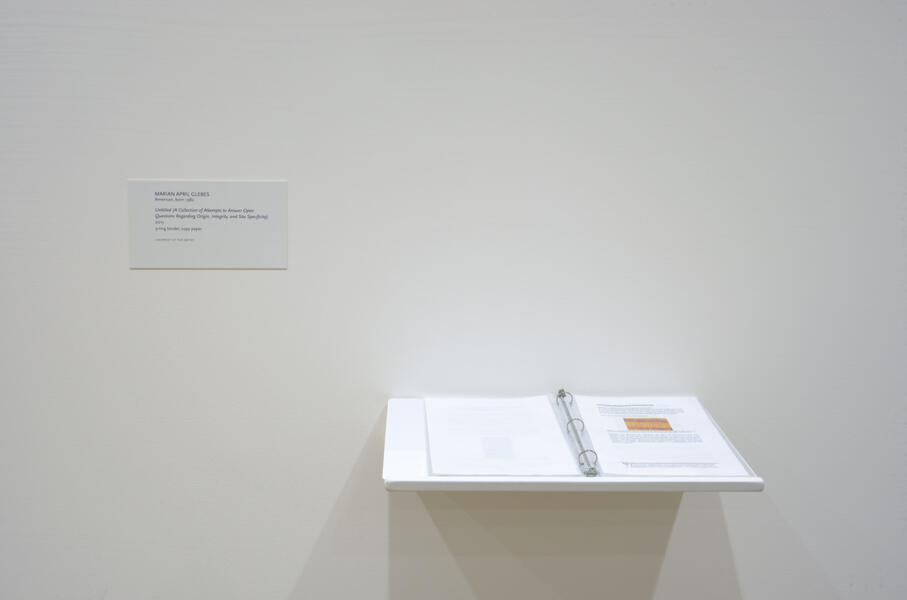 Untitled (A Collection of Attempts to Answer Open Questions Regarding Origin, Integrity, and Site Specificity)MATERIALS: 3 Ring Binder, Copy Paper DIMENSIONS: 12"x9"x2"
Untitled (A Collection of Attempts to Answer Open Questions Regarding Origin, Integrity, and Site Specificity)MATERIALS: 3 Ring Binder, Copy Paper DIMENSIONS: 12"x9"x2"
"Three Sheds for Three Sites, Shed III: Collection Shed (...)"
(One is at the Museum and Performs the Functions of Home, One is at the Salvage Material Re-Use Center and Performs the Functions of the Museum, One is at the Home of the Artist and performs the Functions of A Collection)
DATE: 2015
MATERIALS: Mixed Media & Audience Participation
DIMENSIONS: Dimensions Variable
-
 Three Sheds for Three Sites, Shed III: Collection ShedTITLE: Three Sheds for Three Sites, Shed III: Collection Shed (One is at the Museum and Performs the Functions of Home, One is at the Salvage Material Re-Use Center and Performs the Functions of the Museum, One is at the Home of the Artist and performs the Functions of A Collection) ARTIST:Marian April Glebes DATE: 2015 MATERIALS: Mixed Media & Audience Participation DIMENSIONS: Dimensions Variable
Three Sheds for Three Sites, Shed III: Collection ShedTITLE: Three Sheds for Three Sites, Shed III: Collection Shed (One is at the Museum and Performs the Functions of Home, One is at the Salvage Material Re-Use Center and Performs the Functions of the Museum, One is at the Home of the Artist and performs the Functions of A Collection) ARTIST:Marian April Glebes DATE: 2015 MATERIALS: Mixed Media & Audience Participation DIMENSIONS: Dimensions Variable -
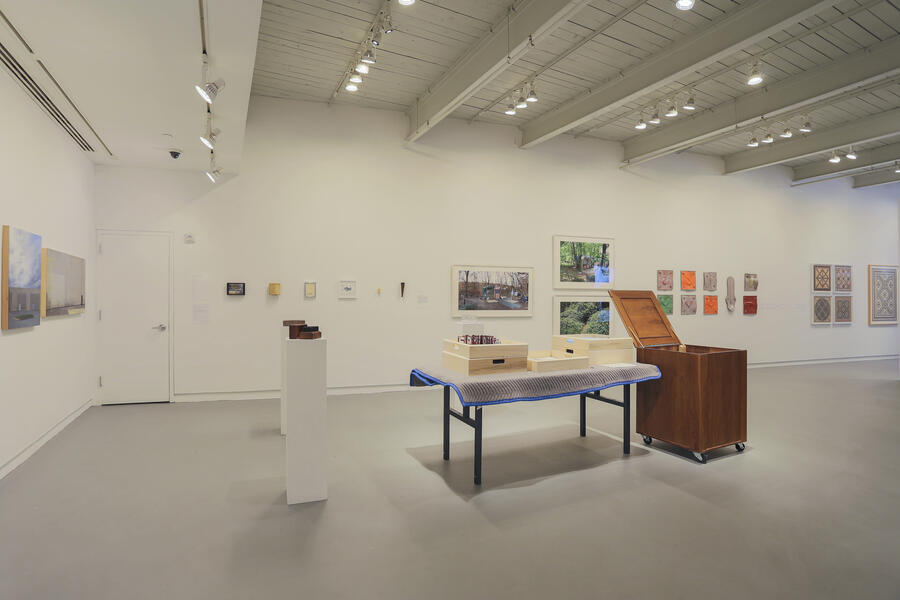 Three Sheds for Three Sites, Shed III: Collection Shed
Three Sheds for Three Sites, Shed III: Collection Shed -
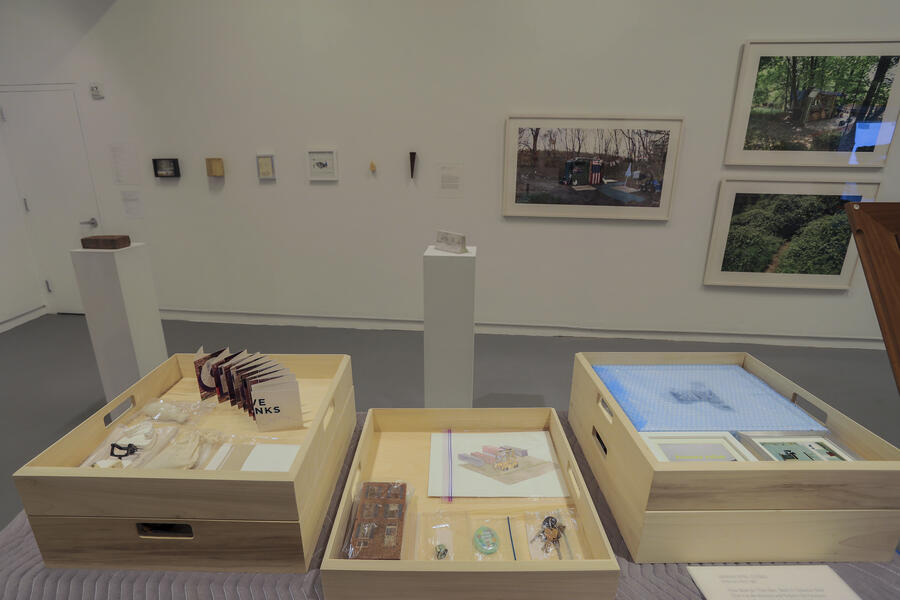 Three Sheds for Three Sites, Shed III: Collection Shed
Three Sheds for Three Sites, Shed III: Collection Shed -
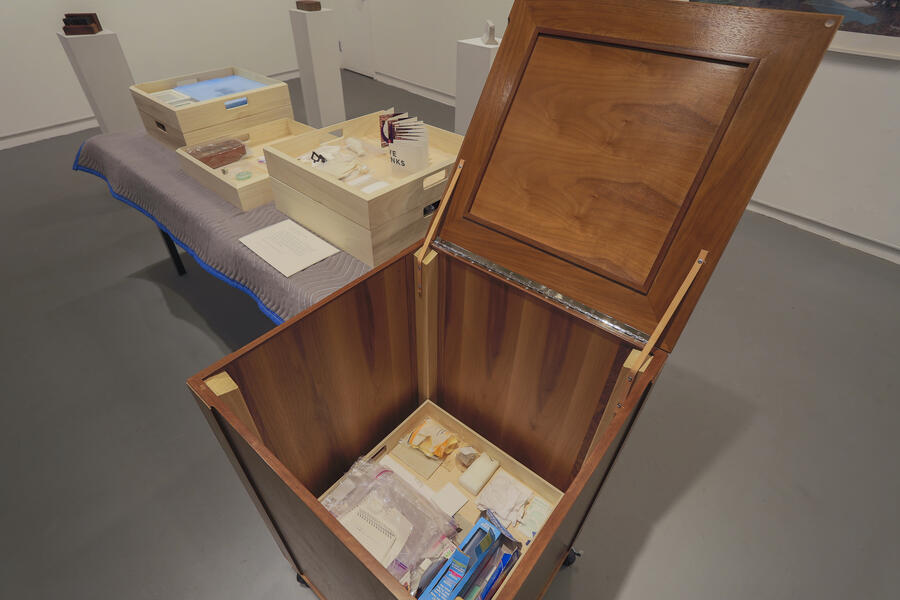 Three Sheds for Three Sites, Shed III: Collection Shed
Three Sheds for Three Sites, Shed III: Collection Shed -
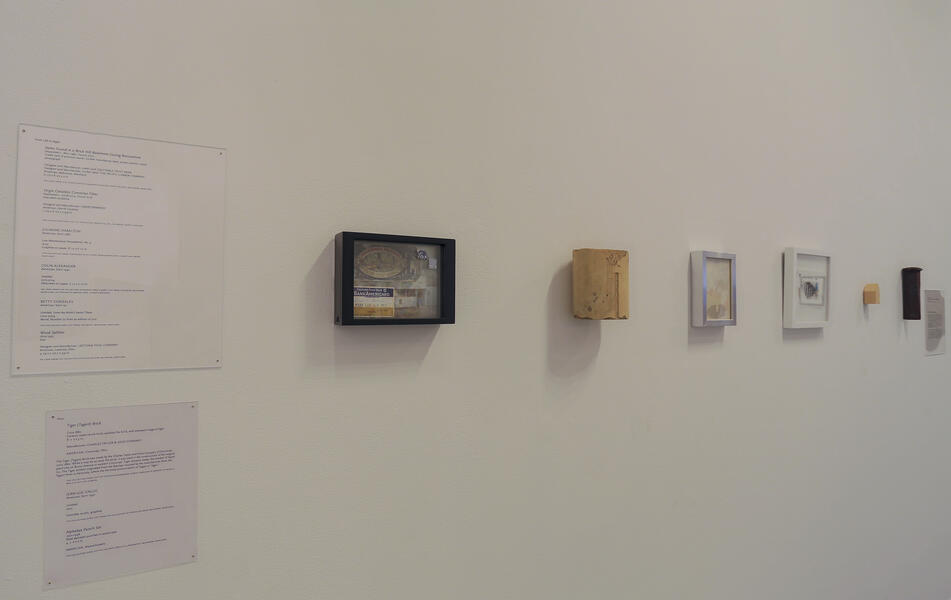 Three Sheds for Three Sites, Shed III: Collection Shed
Three Sheds for Three Sites, Shed III: Collection Shed -
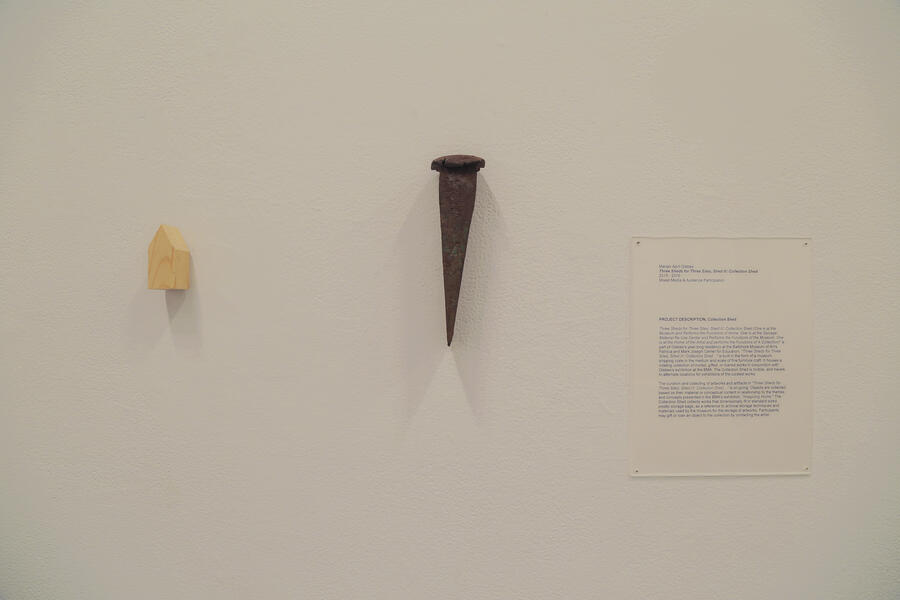 Three Sheds for Three Sites, Shed III: Collection Shed
Three Sheds for Three Sites, Shed III: Collection Shed -
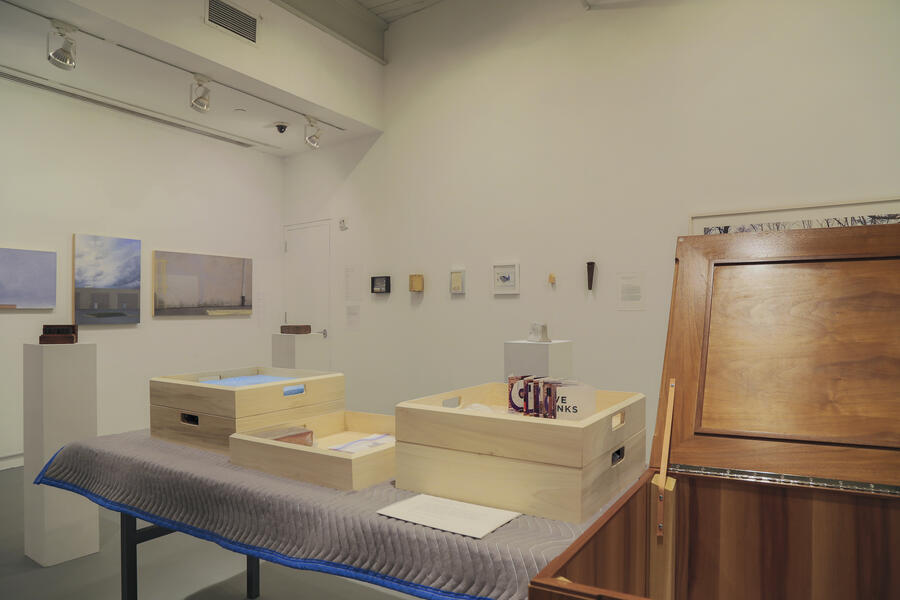 Three Sheds for Three Sites, Shed III: Collection Shed
Three Sheds for Three Sites, Shed III: Collection Shed -
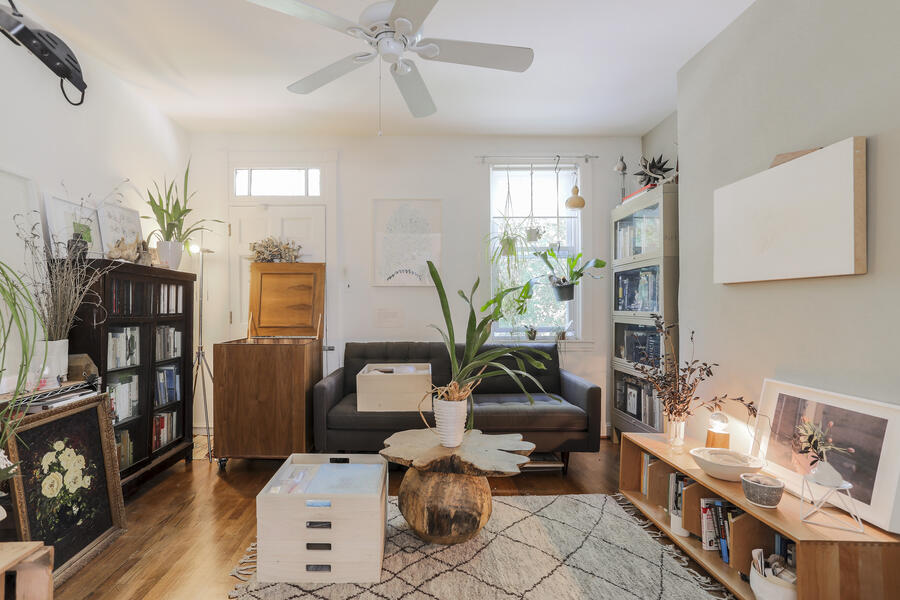 Three Sheds for Three Sites, Shed III: Collection Shed at Home
Three Sheds for Three Sites, Shed III: Collection Shed at Home -
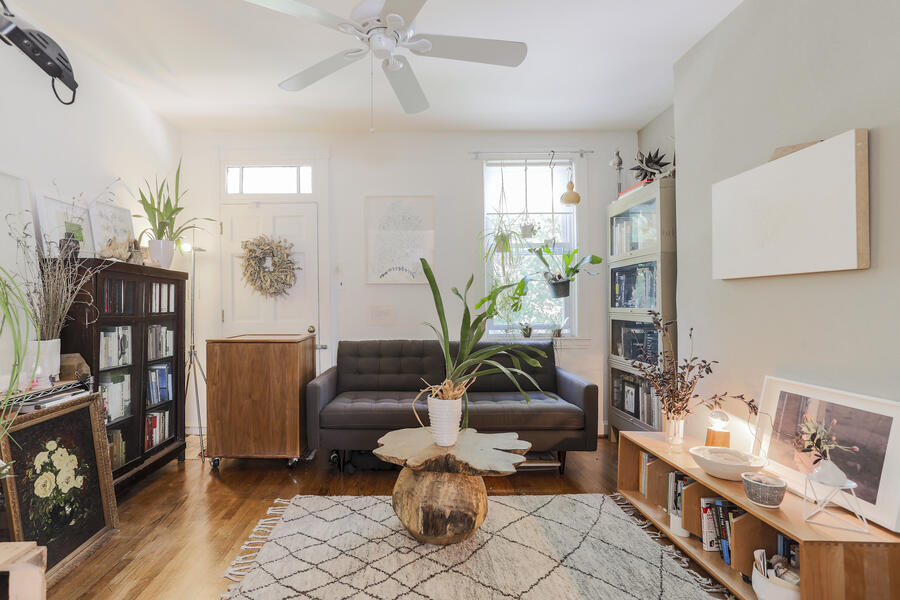 Three Sheds for Three Sites, Shed III: Collection Shed at Home
Three Sheds for Three Sites, Shed III: Collection Shed at Home -
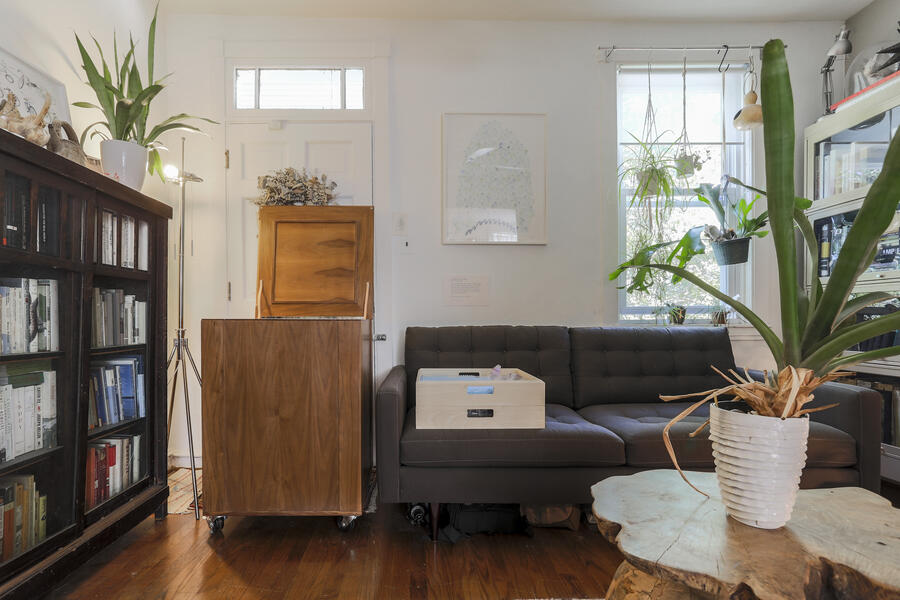 Three Sheds for Three Sites, Shed III: Collection Shed at Home
Three Sheds for Three Sites, Shed III: Collection Shed at Home
from the series "Model Homes"
-
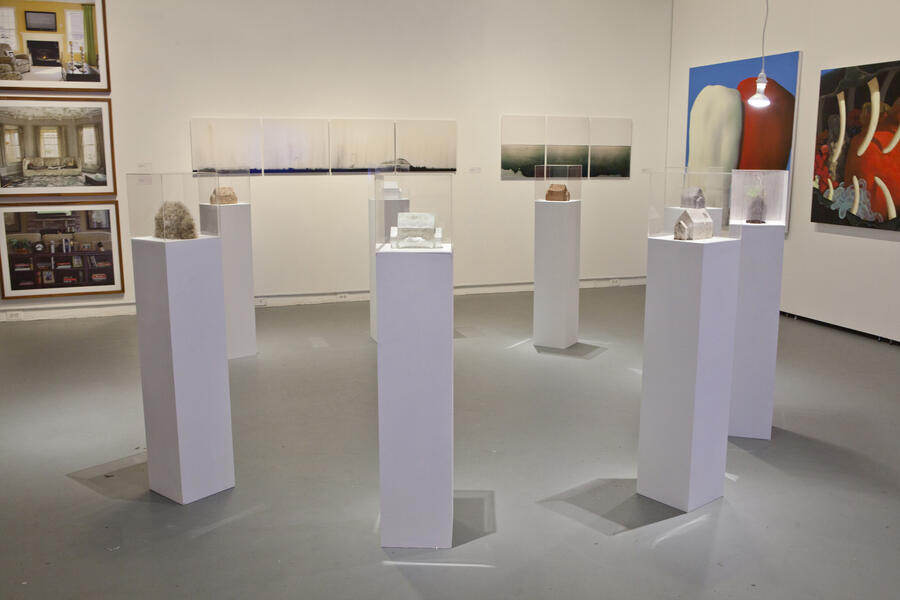 Model Homes, Installation ViewThe majority of the series "Model Homes" was created by compression casting. The casts are not held together by a binding agent, they are monolithic and rely on the properties of each material to maintain their form. The 2 drywall forms were constructed, not cast. The materials for "Model Homes" were collected over an extended period of time by the artist from suburban lawns. (Dandelions were collected over a 3 year period. Lint collected over 6 month period. Grass, 2 months, for example.) Once enough material was collected, it was inserted into the mold. The force to cast the material was applied using a mechanical pressure system designed by the artist. The glass house is sand-cast glass, annealed over 4 days from a liquid glass temperature of 1100 degrees. The pedestals were built by the artist using MDF. The vitrines are plexiglass.
Model Homes, Installation ViewThe majority of the series "Model Homes" was created by compression casting. The casts are not held together by a binding agent, they are monolithic and rely on the properties of each material to maintain their form. The 2 drywall forms were constructed, not cast. The materials for "Model Homes" were collected over an extended period of time by the artist from suburban lawns. (Dandelions were collected over a 3 year period. Lint collected over 6 month period. Grass, 2 months, for example.) Once enough material was collected, it was inserted into the mold. The force to cast the material was applied using a mechanical pressure system designed by the artist. The glass house is sand-cast glass, annealed over 4 days from a liquid glass temperature of 1100 degrees. The pedestals were built by the artist using MDF. The vitrines are plexiglass. -
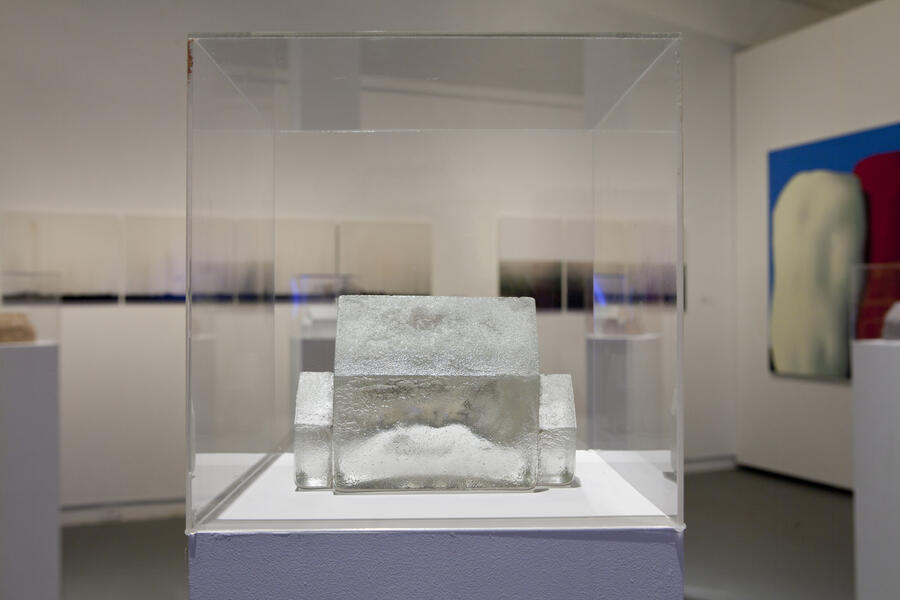 Model Home (Glass)material: Sand-cast Glass "Model Home (Glass)" is sand-cast glass, annealed over 4 days from a liquid glass temperature of 1100 degrees. *made with the assistance of Jeremy Lepisto and Scott Schroeder
Model Home (Glass)material: Sand-cast Glass "Model Home (Glass)" is sand-cast glass, annealed over 4 days from a liquid glass temperature of 1100 degrees. *made with the assistance of Jeremy Lepisto and Scott Schroeder -
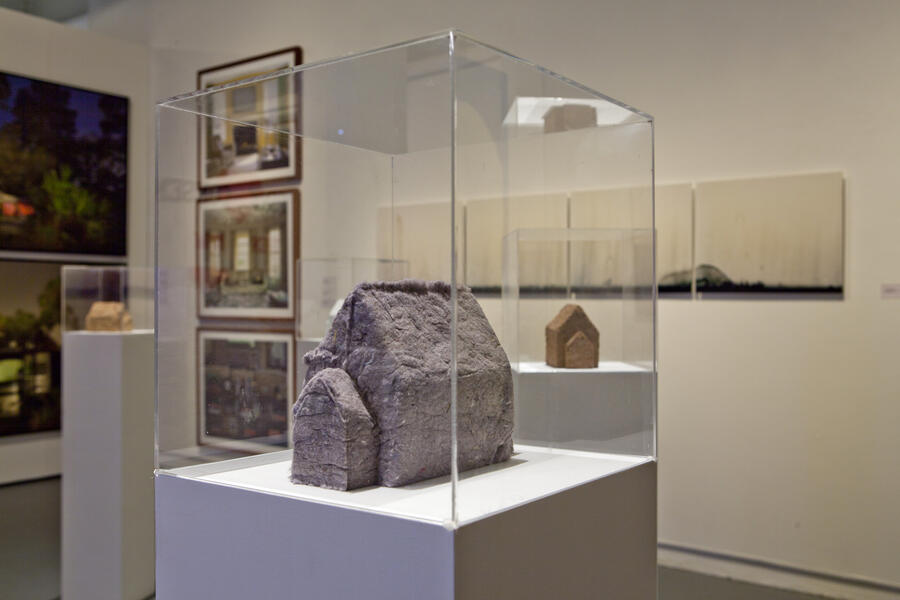 Model Home (Dust)material: Dryer Lint Dryer lint was collected over a period of 6 months from the home of the artist and others, blended, then compression cast to form "Model Home (Dust)"
Model Home (Dust)material: Dryer Lint Dryer lint was collected over a period of 6 months from the home of the artist and others, blended, then compression cast to form "Model Home (Dust)" -
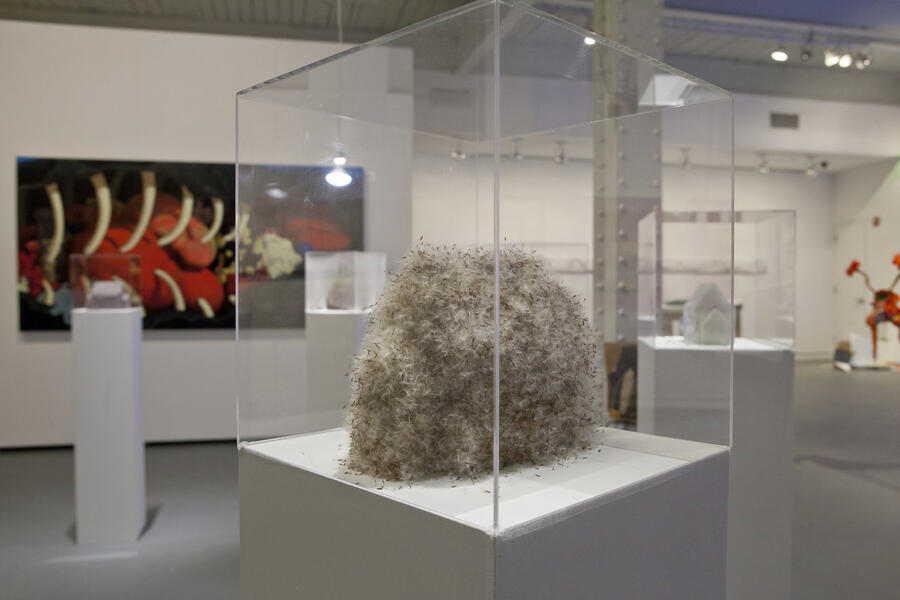 Model Home (Dandelion III)material: Dandelion seeds The artist collected Dandelion seeds from neighborhood lawns over a 3 year period. The Dandelion house is monolithic, relying only on the properties of the material to maintain its form.
Model Home (Dandelion III)material: Dandelion seeds The artist collected Dandelion seeds from neighborhood lawns over a 3 year period. The Dandelion house is monolithic, relying only on the properties of the material to maintain its form. -
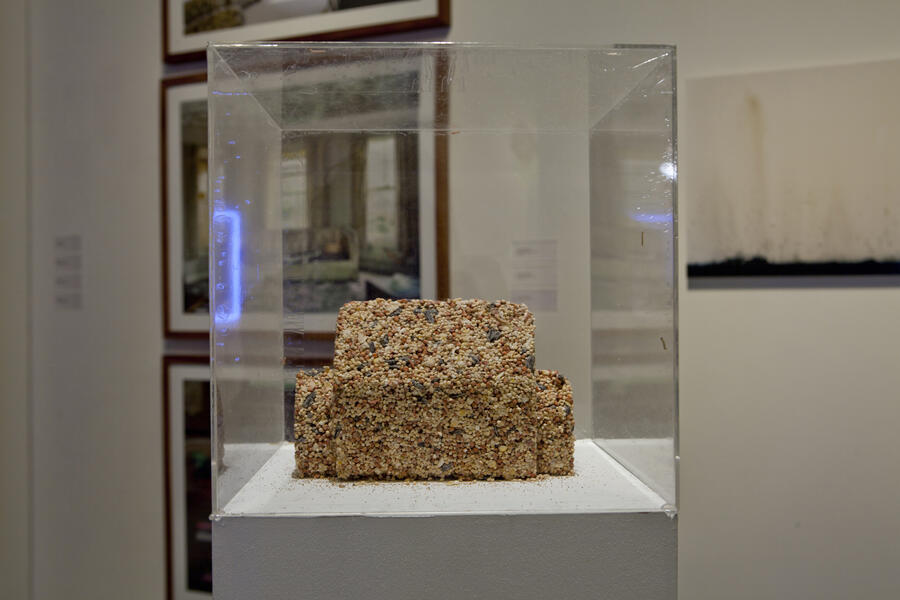 Model Home (Birdseed, Model I)materials: birdseed The birdseed house is in a constant state of entropy. As the material maintains its edibility in cast form, it is consumed by moths as it is exhibited. This ecology is sealed in the vitrine.
Model Home (Birdseed, Model I)materials: birdseed The birdseed house is in a constant state of entropy. As the material maintains its edibility in cast form, it is consumed by moths as it is exhibited. This ecology is sealed in the vitrine. -
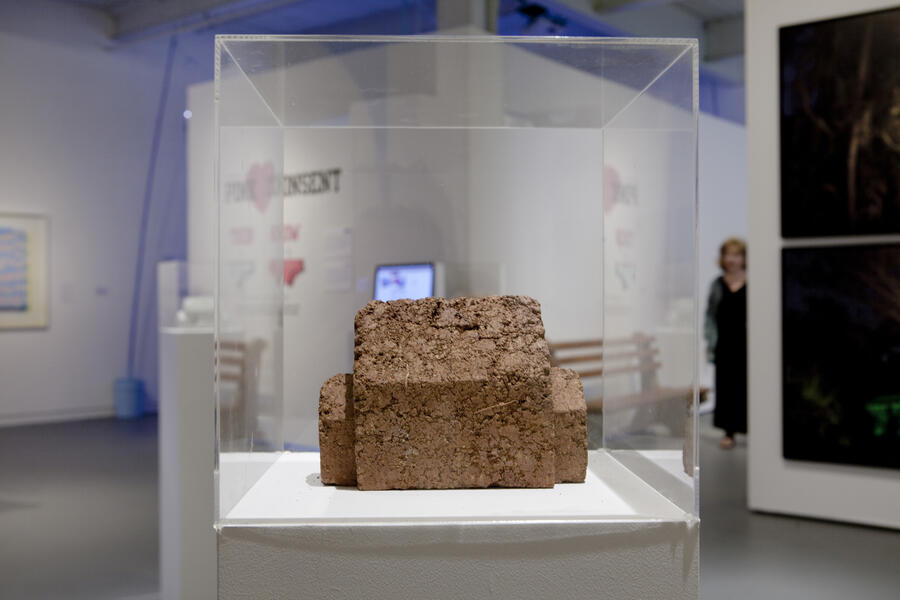 Model Home (Earth, Model VII)material: Rammed Earth
Model Home (Earth, Model VII)material: Rammed Earth -
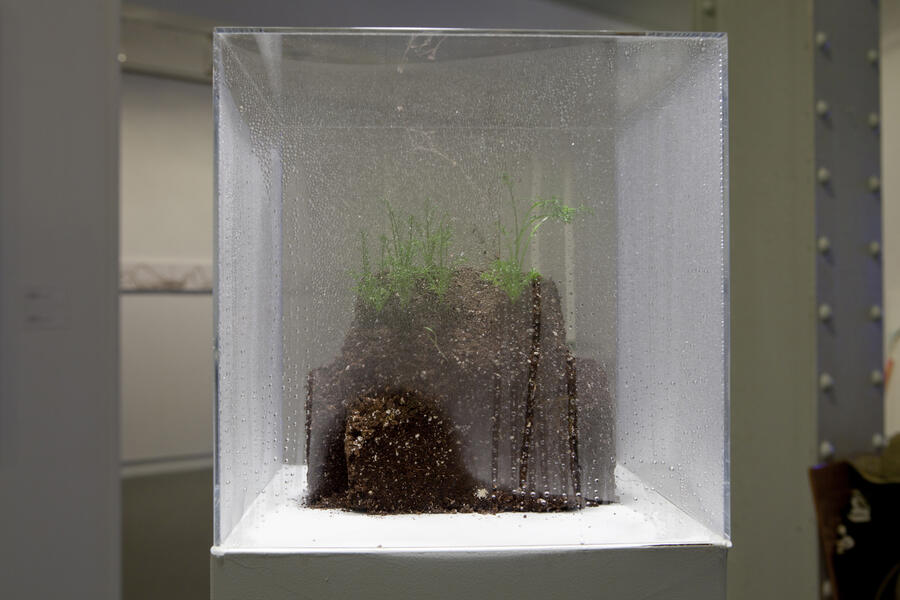 Model Home (Soil IIX)materials: Potting Soil, Baby's Breath and Chamomile Plants, UV Light Cast potting soil was embedded with plant seeds and kept moist, enabling the plants to sprout and grow. As the plants developed, their root structure eroded the legibility of the house form. The ecology was sealed under the vitrine.
Model Home (Soil IIX)materials: Potting Soil, Baby's Breath and Chamomile Plants, UV Light Cast potting soil was embedded with plant seeds and kept moist, enabling the plants to sprout and grow. As the plants developed, their root structure eroded the legibility of the house form. The ecology was sealed under the vitrine. -
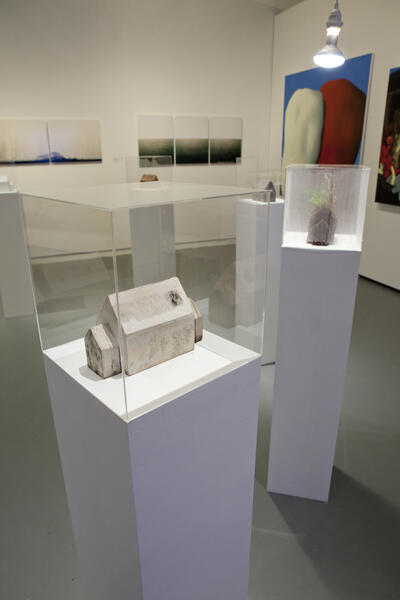 Model Home (Drywall) - installation viewmaterials: Drywall, Joint Compound, Mold A model home was built out of drywall, mudded, and sanded to a perfect finish. The final model was enclosed in an airtight plastic container in a bath of water and left to grow mold for three months.
Model Home (Drywall) - installation viewmaterials: Drywall, Joint Compound, Mold A model home was built out of drywall, mudded, and sanded to a perfect finish. The final model was enclosed in an airtight plastic container in a bath of water and left to grow mold for three months. -
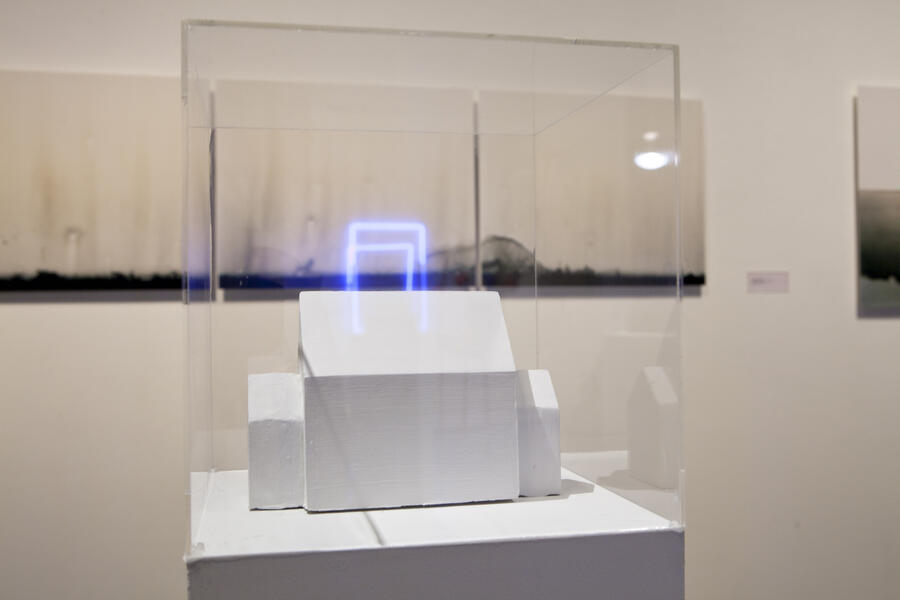 Model Home (Drywall IV)material: Drywall, Joint Compound, Latex Housepaint
Model Home (Drywall IV)material: Drywall, Joint Compound, Latex Housepaint
Baltimore Mobile Community Brick Factory & Monument
The Baltimore Mobile Community Brick Factory produces handmade bricks from local Maryland clay using historic waterstruck wooden mold methods. We invite the people of Baltimore to join us in making the bricks and personalizing them by inscribing stories and ideas about home, place, history and personal experience. The bricks made by the Baltimore Mobile Community Brick Factory, after firing, become a part of a series of public art installations. This exhibition at Baltimore Clayworks is the first installation of the wood-fired bricks. The Baltimore Mobile Community Brick Factory is Marian April Glebes in collaboration with Josh Copus and you.
Brickmaking occurred during the Spring and Summer of 2016.
The Baltimore Mobile Community Brick Factory is made possible, in part, by a 2015 Rubys Artist Project Grant, an initiative conceived with start-up funding from the Robert W. Deutsch Foundation and is a program of the Greater Baltimore Cultural Alliance.
The Baltimore Mobile Community Brick Factory Bricks
Baltimore Clayworks, Project Space
October 14, 2016 - November 13, 2016
This installation at Baltimore Clayworks included over 650 bricks from the first woodfiring of the bricks we made as the Baltimore Mobile Community Brick Factory. The floor configuration was installed in the project space and occupied 160 square feet. Visitors we invited to walk on the bricks to read the inscriptions.
-
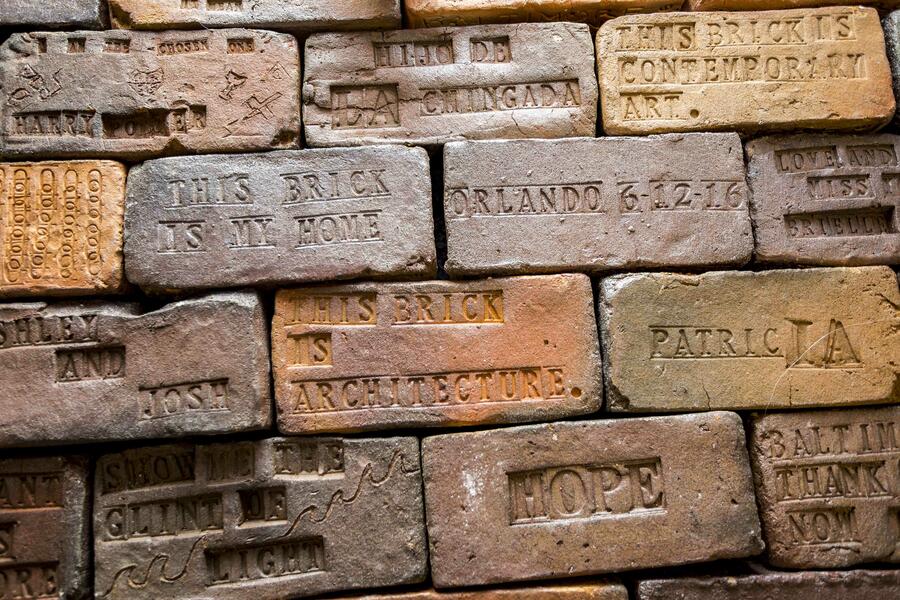 Bricks made by Baltimore Mobile Community Brick FactoryThe Baltimore Mobile Community Brick Factory Bricks Baltimore Clayworks, Project Space October 14, 2016 - November 13, 2016 This installation at Baltimore Clayworks included over 650 bricks from the first woodfiring of the bricks we made as the Baltimore Mobile Community Brick Factory. The floor configuration was installed in the project space and occupied 160 square feet. Visitors we invited to walk on the bricks to read the inscriptions.
Bricks made by Baltimore Mobile Community Brick FactoryThe Baltimore Mobile Community Brick Factory Bricks Baltimore Clayworks, Project Space October 14, 2016 - November 13, 2016 This installation at Baltimore Clayworks included over 650 bricks from the first woodfiring of the bricks we made as the Baltimore Mobile Community Brick Factory. The floor configuration was installed in the project space and occupied 160 square feet. Visitors we invited to walk on the bricks to read the inscriptions. -
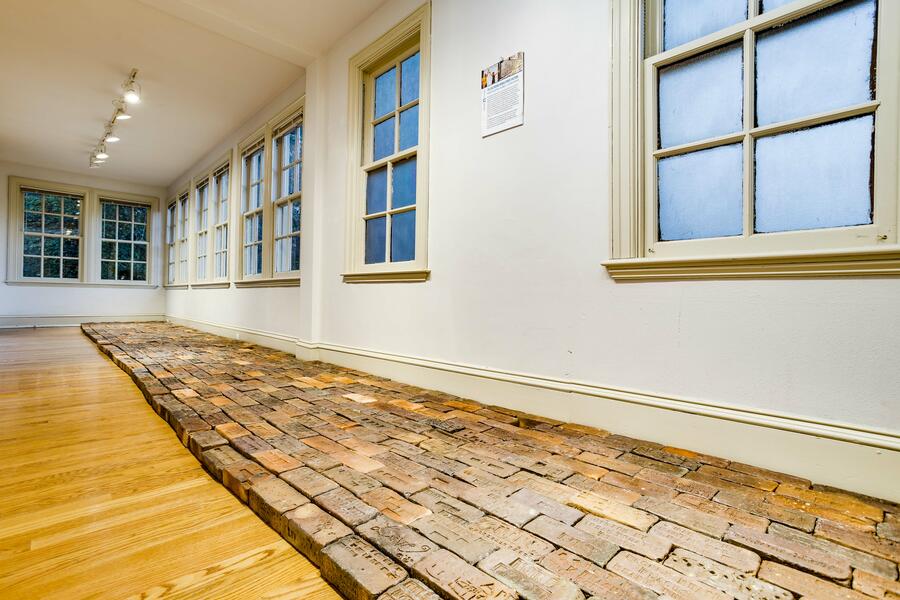 Baltimore Mobile Community Brick Factory Brick Installation ViewThe Baltimore Mobile Community Brick Factory Bricks Baltimore Clayworks, Project Space October 14, 2016 - November 13, 2016 This installation at Baltimore Clayworks included over 650 bricks from the first woodfiring of the bricks we made as the Baltimore Mobile Community Brick Factory. The floor configuration was installed in the project space and occupied 160 square feet. Visitors we invited to walk on the bricks to read the inscriptions.
Baltimore Mobile Community Brick Factory Brick Installation ViewThe Baltimore Mobile Community Brick Factory Bricks Baltimore Clayworks, Project Space October 14, 2016 - November 13, 2016 This installation at Baltimore Clayworks included over 650 bricks from the first woodfiring of the bricks we made as the Baltimore Mobile Community Brick Factory. The floor configuration was installed in the project space and occupied 160 square feet. Visitors we invited to walk on the bricks to read the inscriptions. -
 Bricks made by the Baltimore mobile Community Brick FactoryThe Baltimore Mobile Community Brick Factory Bricks Baltimore Clayworks, Project Space October 14, 2016 - November 13, 2016 This installation at Baltimore Clayworks included over 650 bricks from the first woodfiring of the bricks we made as the Baltimore Mobile Community Brick Factory. The floor configuration was installed in the project space and occupied 160 square feet. Visitors we invited to walk on the bricks to read the inscriptions. The Baltimore Mobile Community Brick Factory produces handmade bricks from local Maryland clay using historic waterstruck wooden mold methods. We invite the people of Baltimore to join us in making the bricks and personalizing them by inscribing stories and ideas about home, place, history and personal experience. The bricks made by the Baltimore Mobile Community Brick Factory, after firing, become a part of a series of public art installations. This exhibition at Baltimore Clayworks is the first installation of the bricks. The Baltimore Mobile Community Brick Factory is Marian April Glebes with Josh Copus and you. The Baltimore Mobile Community Brick Factory is made possible, in part, by a 2015 Rubys Artist Project Grant, an initiative conceived with start-up funding from the Robert W. Deutsch Foundation and is a program of the Greater Baltimore Cultural Alliance
Bricks made by the Baltimore mobile Community Brick FactoryThe Baltimore Mobile Community Brick Factory Bricks Baltimore Clayworks, Project Space October 14, 2016 - November 13, 2016 This installation at Baltimore Clayworks included over 650 bricks from the first woodfiring of the bricks we made as the Baltimore Mobile Community Brick Factory. The floor configuration was installed in the project space and occupied 160 square feet. Visitors we invited to walk on the bricks to read the inscriptions. The Baltimore Mobile Community Brick Factory produces handmade bricks from local Maryland clay using historic waterstruck wooden mold methods. We invite the people of Baltimore to join us in making the bricks and personalizing them by inscribing stories and ideas about home, place, history and personal experience. The bricks made by the Baltimore Mobile Community Brick Factory, after firing, become a part of a series of public art installations. This exhibition at Baltimore Clayworks is the first installation of the bricks. The Baltimore Mobile Community Brick Factory is Marian April Glebes with Josh Copus and you. The Baltimore Mobile Community Brick Factory is made possible, in part, by a 2015 Rubys Artist Project Grant, an initiative conceived with start-up funding from the Robert W. Deutsch Foundation and is a program of the Greater Baltimore Cultural Alliance -
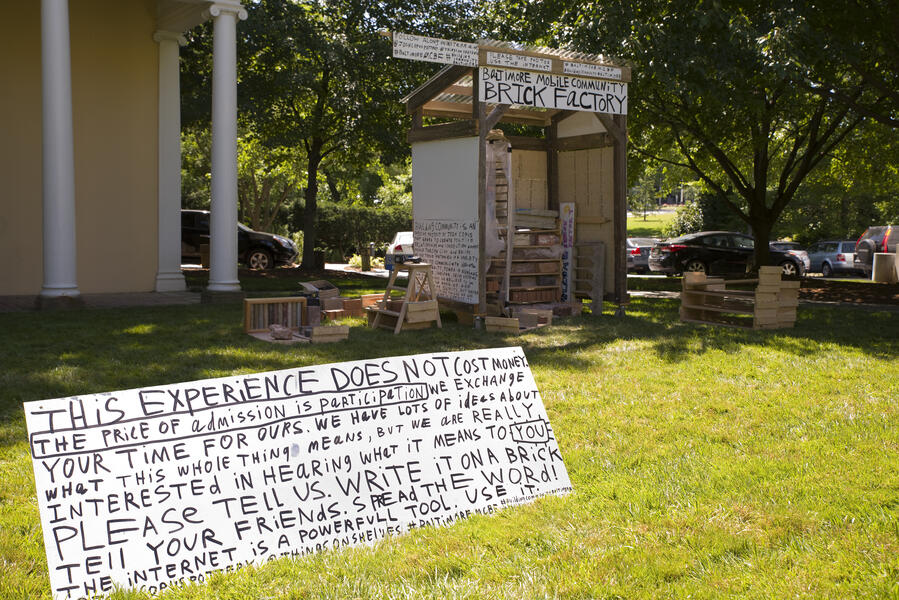 Baltimore Mobile Community Brick Factory on the Spring House Lawn at the BMA
Baltimore Mobile Community Brick Factory on the Spring House Lawn at the BMA -
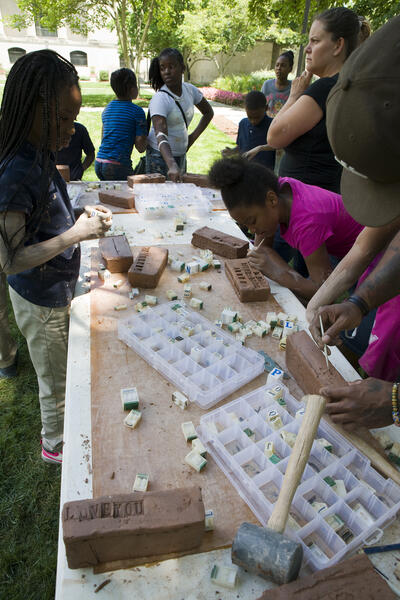 Telling stories in bricks at the Brick Factory
Telling stories in bricks at the Brick Factory -
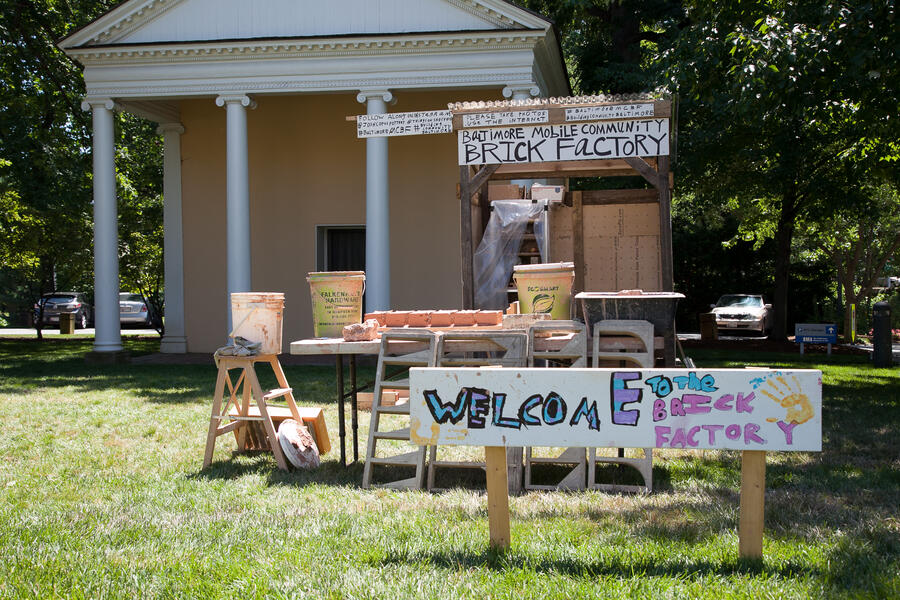 Welcome to the Baltimore Mobile Community Brick Factory's Brickmaking Station
Welcome to the Baltimore Mobile Community Brick Factory's Brickmaking Station -
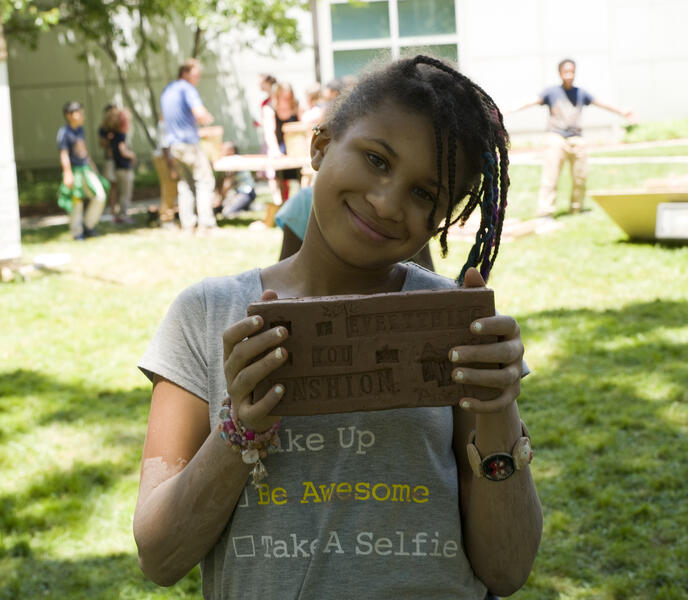 Margaret Brent Middle School 4th Graders visit the Brick Factory
Margaret Brent Middle School 4th Graders visit the Brick Factory -
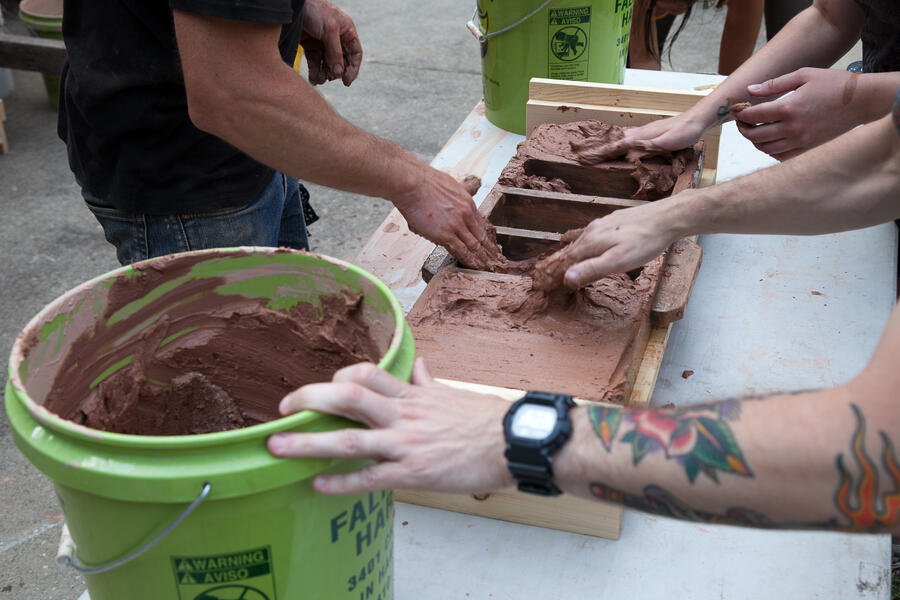 Making bricks at the Baltimore Mobile Community Brick Factory
Making bricks at the Baltimore Mobile Community Brick Factory
"In Defense of Native Soil"
-
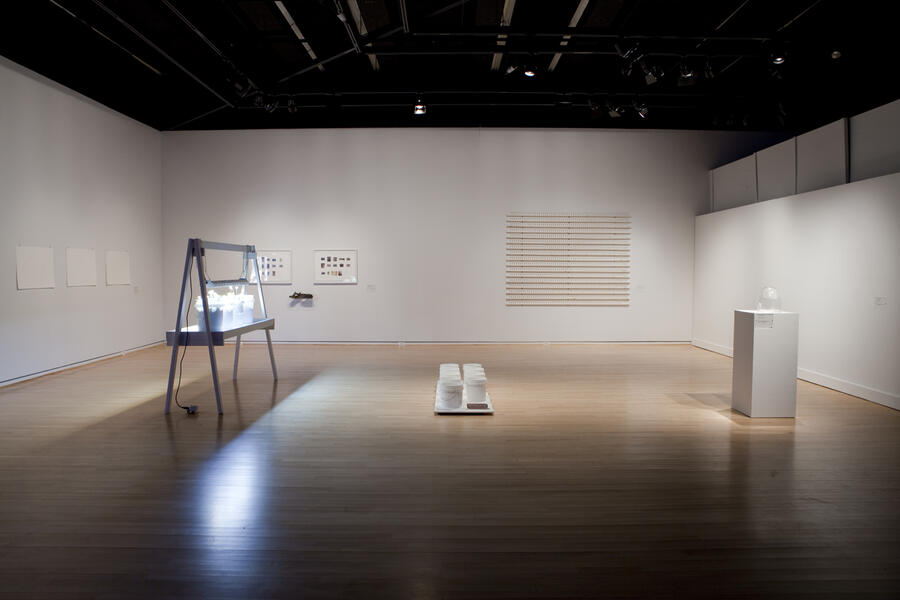 Installation View: In Defense of Native Soil
Installation View: In Defense of Native Soil -
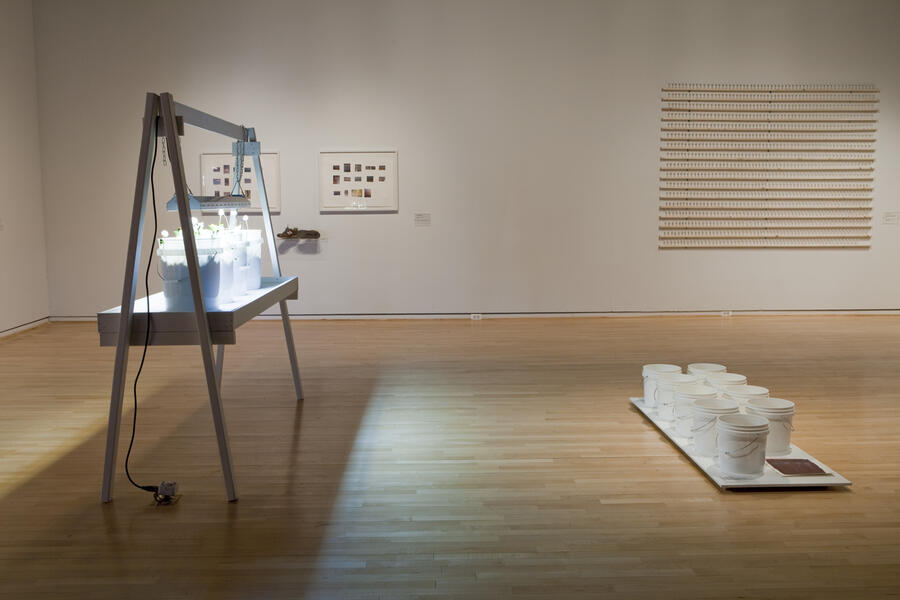 Installation: â??Water, collected from leaking faucets, is used to facilitate the printing of 1 (one) unfixed salt print, recollected, and then used to water dandelions.â?materials: water, buckets, wood, dirt, latex paint, light, paper, dandelions
Installation: â??Water, collected from leaking faucets, is used to facilitate the printing of 1 (one) unfixed salt print, recollected, and then used to water dandelions.â?materials: water, buckets, wood, dirt, latex paint, light, paper, dandelionsIn this work, Glebes collected leaking water from faucets in Baltimore City. THe water was then distilled and used to print one unfixed salt print. The water was then recollected and displayed in the gallery and used to water a crop of dandelions for the duration of the exhibition. The salt print was displayed with the water and faded to invisibility over the month.
-
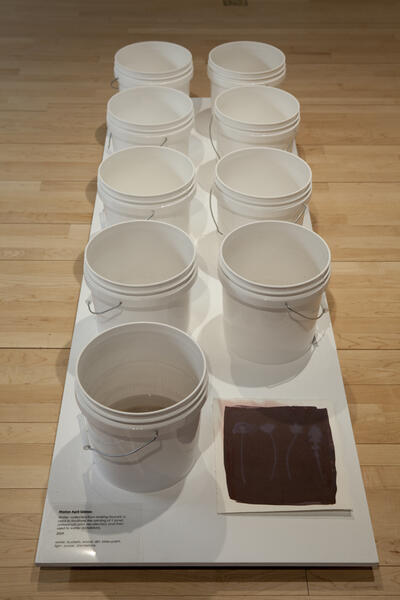 Installation, Detail: â??Water, collected from leaking faucets, is used to facilitate the printing of 1 (one) unfixed salt print, recollected, and then used to water dandelions.â?
Installation, Detail: â??Water, collected from leaking faucets, is used to facilitate the printing of 1 (one) unfixed salt print, recollected, and then used to water dandelions.â?In this work, Glebes collected leaking water from faucets in Baltimore City. THe water was then distilled and used to print one unfixed salt print. The water was then recollected and displayed in the gallery and used to water a crop of dandelions for the duration of the exhibition. The salt print was displayed with the water and faded to invisibility over the month.
-
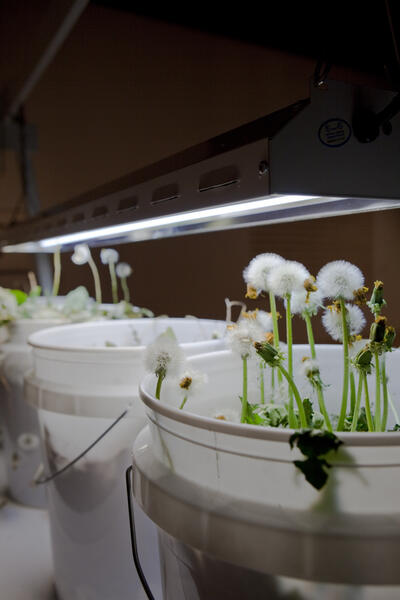 Installation, Detail: â??Water, collected from leaking faucets, is used to facilitate the printing of 1 (one) unfixed salt print, recollected, and then used to water dandelions.â?
Installation, Detail: â??Water, collected from leaking faucets, is used to facilitate the printing of 1 (one) unfixed salt print, recollected, and then used to water dandelions.â?In this work, Glebes collected leaking water from faucets in Baltimore City. THe water was then distilled and used to print one unfixed salt print. The water was then recollected and displayed in the gallery and used to water a crop of dandelions for the duration of the exhibition. The salt print was displayed with the water and faded to invisibility over the month.
-
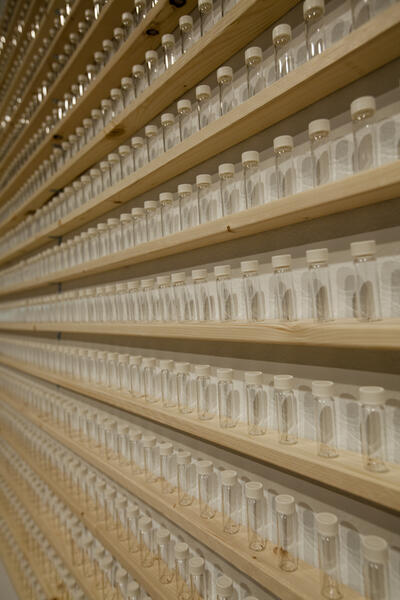 Installation, Detail: 1000 Dandelion Seeds, Harvested on an Early Day in Fall from the Front Yardâ?
Installation, Detail: 1000 Dandelion Seeds, Harvested on an Early Day in Fall from the Front Yardâ?materials: 1000 scintillation vials, 1000 dandelion seeds, wood, brackets
-
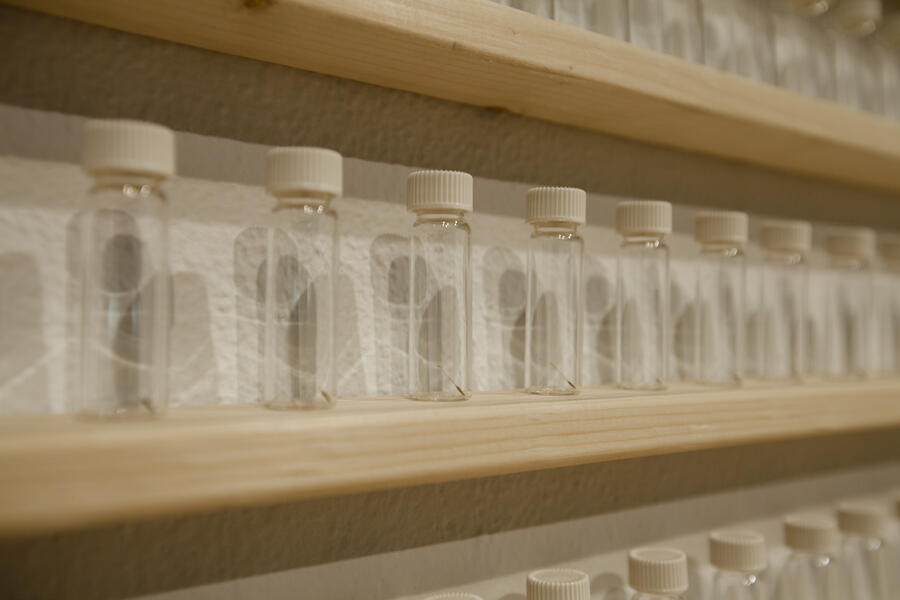 Installation, Detail: "1000 Dandelion Seeds, Harvested on an Early Day in Fall from the Front Yard"
Installation, Detail: "1000 Dandelion Seeds, Harvested on an Early Day in Fall from the Front Yard"materials: 1000 scintillation vials, 1000 dandelion seeds, wood, brackets
-
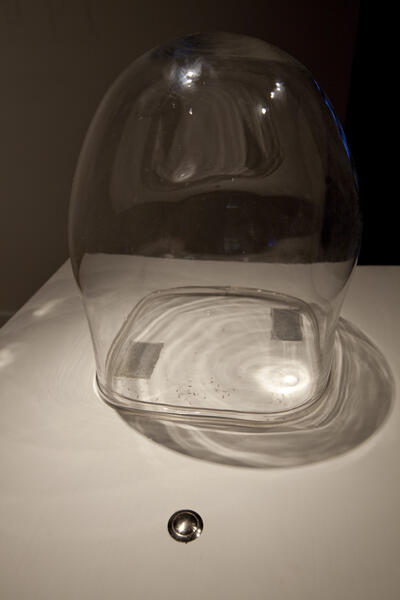 Sculpture, Detail: "Wish Machine"materials: seeds of one dandelion, glass dome, fans, button
Sculpture, Detail: "Wish Machine"materials: seeds of one dandelion, glass dome, fans, buttonIn "Wish Machine," the seeds of one dandelion are sealed atop a pedestal under a glass dome. Viewers may push a button on the pedestal, activating fans which blow the seeds around the dome. This enables them to wish on the dandelion repeatedly without fear of the seeds populating manicured lawns.
-
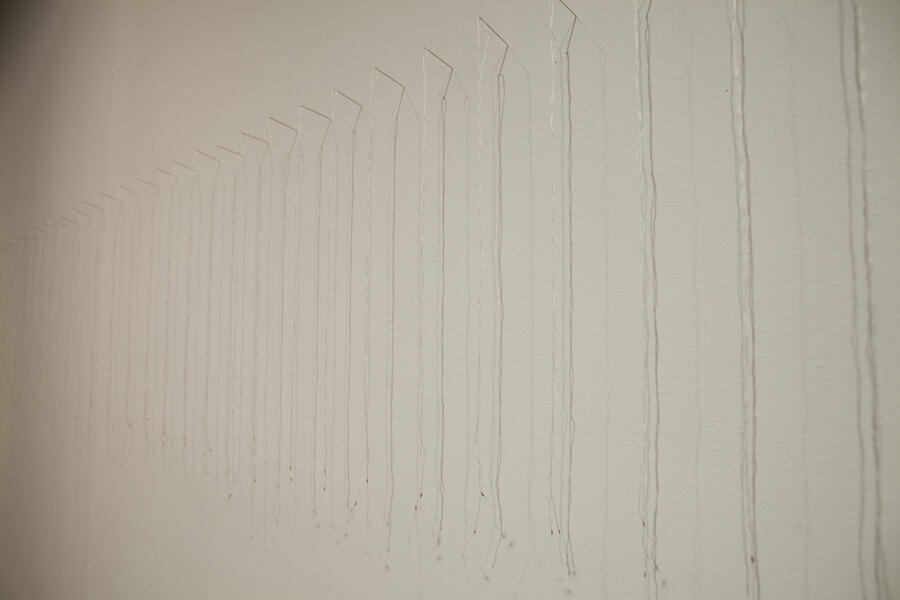 Tethered
Tetheredmaterials: seeds of one (1) Dandelion, embroidery thread, needles
Dimensions Variable, approx. 8"x16'
In "Tethered" dandelion seeds are glued to the ends of embroidery thread, which is suspended from needles pinned to the wall. The piece allows the viewer to "wish" on the dandelion seeds as a child would, without the danger of the seeds escaping to contaminate lawns and gardens. The work addresses the futility of repair and the desire to control the uncontrollable. This piece is a solution to the American fear of the unmanicured lawn, and our attempts to perfect nature and it's unpredictable elements.
-
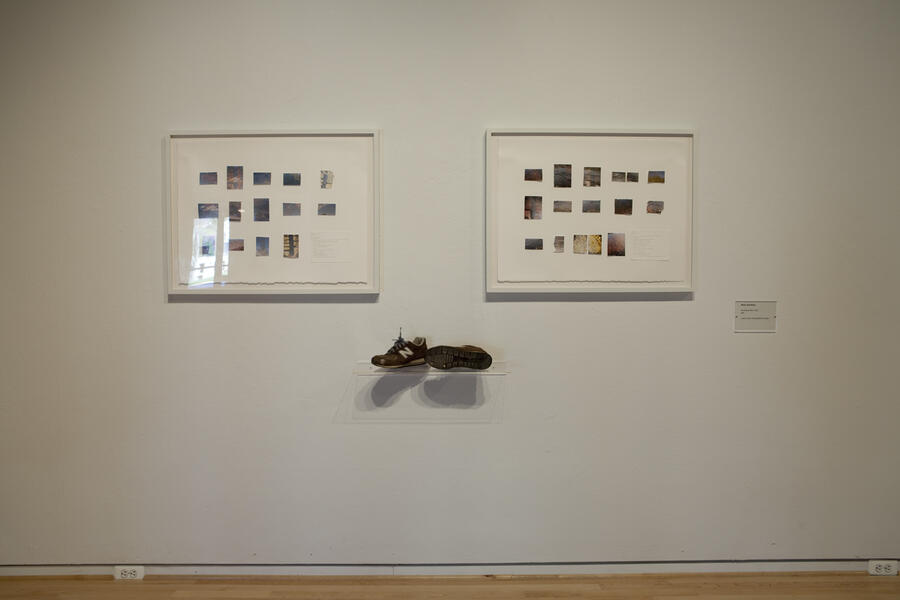 "Treading on Sea, on Sky"
"Treading on Sea, on Sky"dimensions variable, approx. 4'x7'
project description: In "Treading on Sea, on Sky," Glebes photographed the sky above and the water contained in the reservoirs around Baltimore City. Over the course of several months, Glebes wore the prints of the photographs on the soles of her shoes as she attended to her day to day. The resulting artifacts are accompanied by ambiguous descriptions of her activities and her most frequently worn pair of shoes.
-
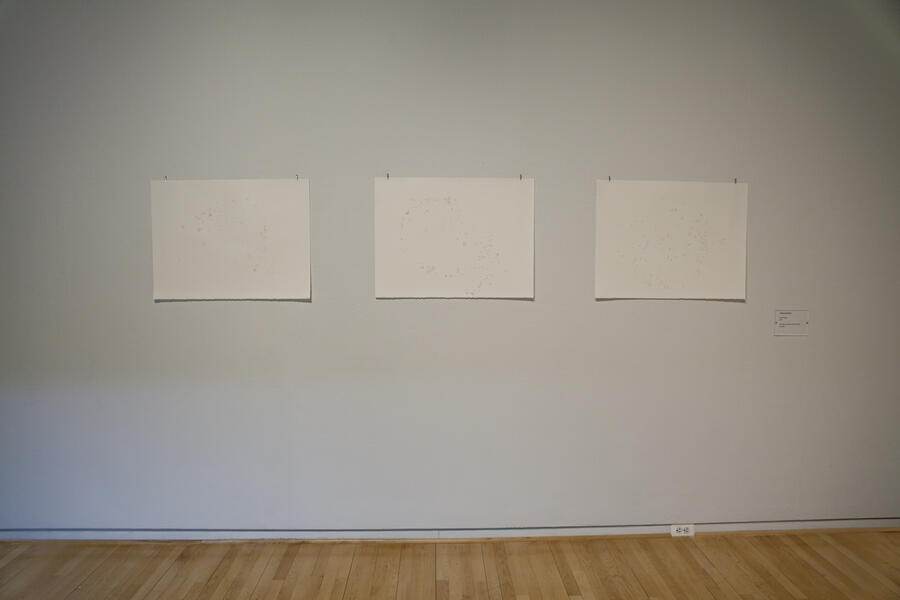 Three Wishes
Three Wishesmaterials: seeds of three dandelions, arches 88
In "Three Wishes," Glebes made a wish on a dandelion. The seeds from the wish were allowed to land only on one sheet of paper. She then affixed them to the paper exactly as they landed. The process was repeated three times.
from the series "Misplaced Altruism/Vanity of Aid"
Glebes's work is created from the remnants of elaborate processes that are futile and ridiculous, metaphoric, and temporary. Her insect repairs are grotesque mortuarial attempts to preserve or mend, meticulous gestures executed on found carcasses, symbolic of an impulse to restore order in a fragile environment and to fill a void created by patheticness in form. This adornment or patching of battered insect bodies is misplaced altruism, which quells the vanities in aid or pity by indulging the most absurd and effete of generosities: squandered restoration and functionless beauty. Glebes's insects are victims of glass windows, selected for mending and decorative preservation for their pitiable state - their brokenness is evaluated by their failure and resulting decay. The repairs and prosthetics imposed on these insects sanction sympathy for the manicured via the restorative maintenance of post-mortem fragility that definalizes the terminal.
-
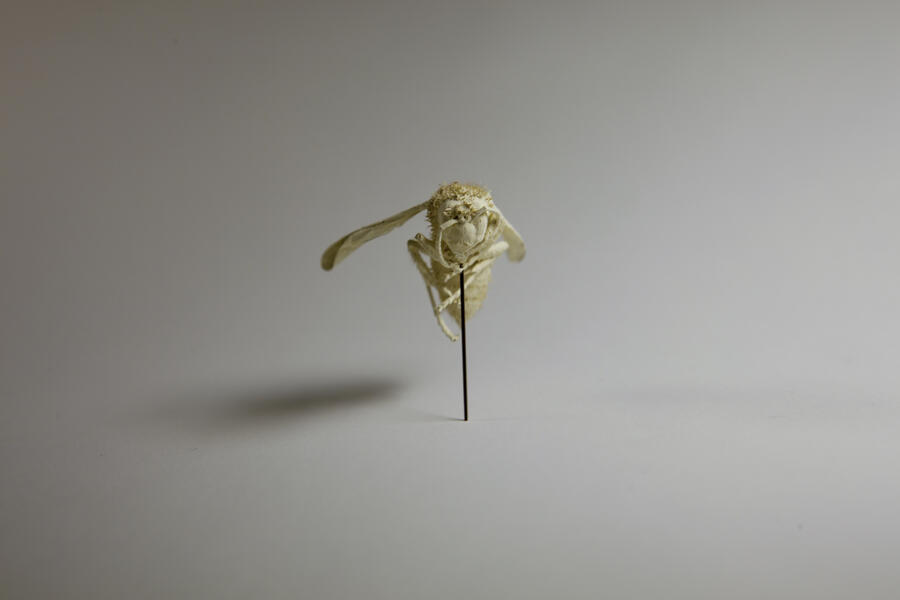 untitled attempt (whitewashed)Hornet, Acrylic Paint, Needle
untitled attempt (whitewashed)Hornet, Acrylic Paint, Needle -
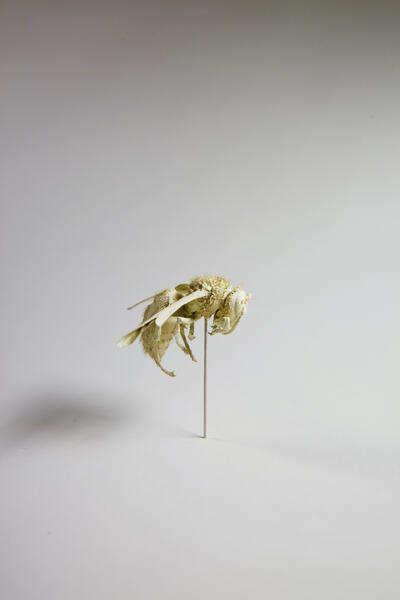 Untitled Attempt (Whitewashed)hornet, acrylic paint, needle
Untitled Attempt (Whitewashed)hornet, acrylic paint, needle -
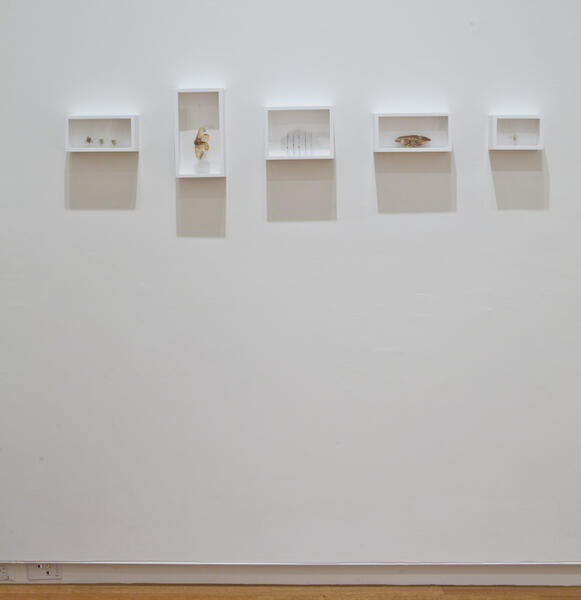 installation view
installation view -
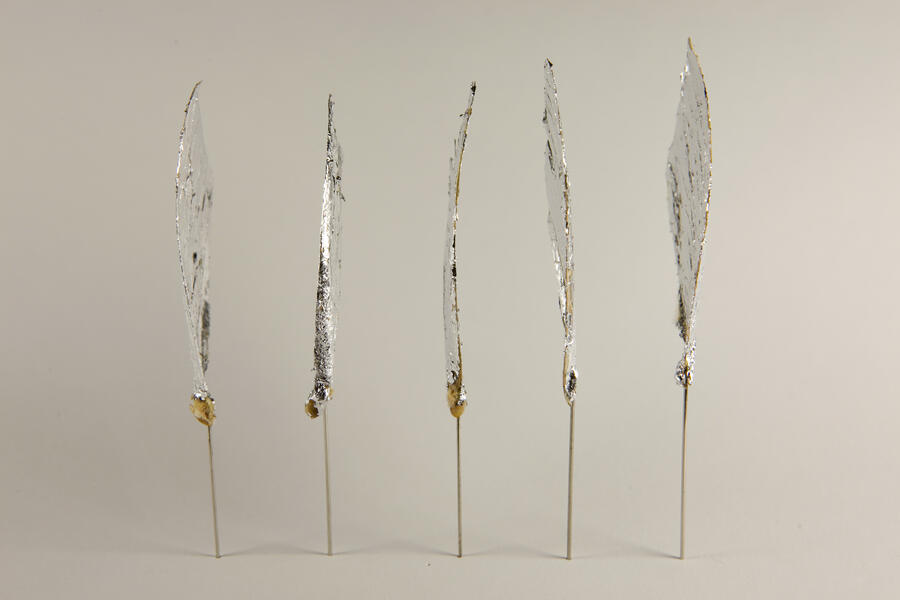 Untitled Repair (silver leaf, five attempts of 7)silver leaf, moth wings
Untitled Repair (silver leaf, five attempts of 7)silver leaf, moth wings -
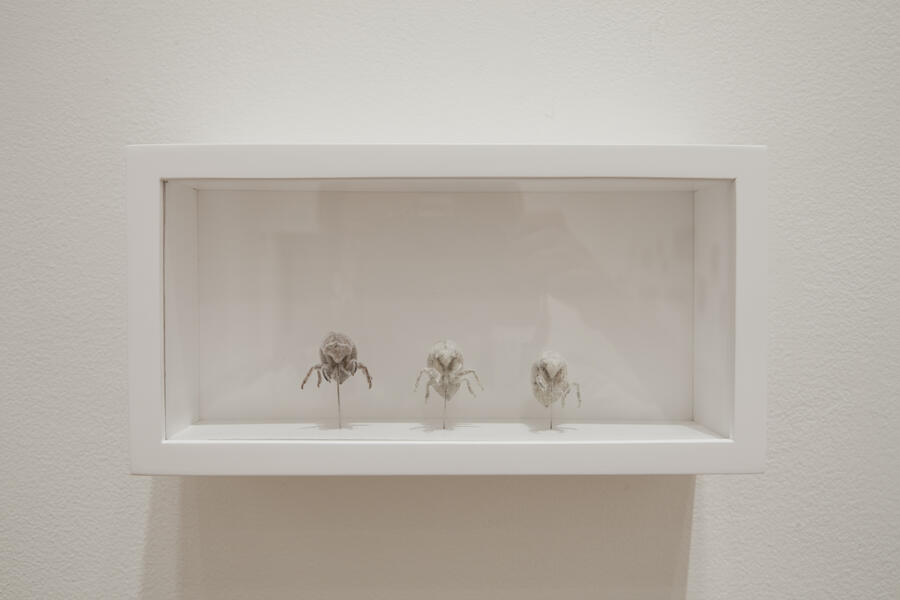 untitled (flocking, three attempts of five)cicada shells, flocking, acrylic paint, needles
untitled (flocking, three attempts of five)cicada shells, flocking, acrylic paint, needles -
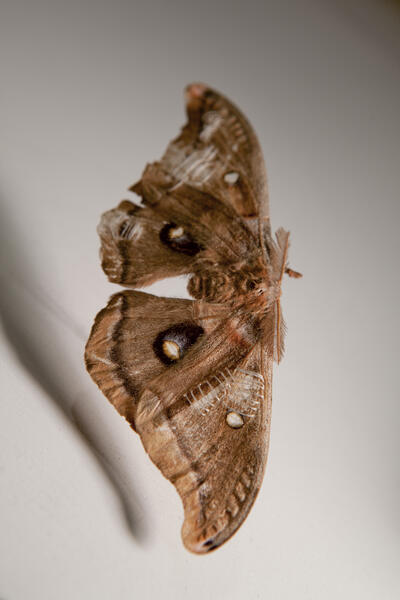 Untitled (stitched, fourth attempt)moth, sewing thread, needle
Untitled (stitched, fourth attempt)moth, sewing thread, needle -
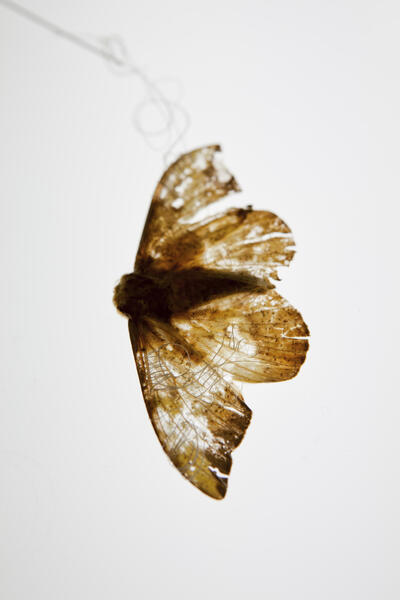 Untitled (stitched, first attempt)moth, sewing thread, needle
Untitled (stitched, first attempt)moth, sewing thread, needle
"Make Yourself Useful" & "Dream A Highway"
Glebes's solo exhibition "Dream A Highway" at Hood College, Frederick MD, included "Throne" and "Untitled (Monitored)" in 2014.
-
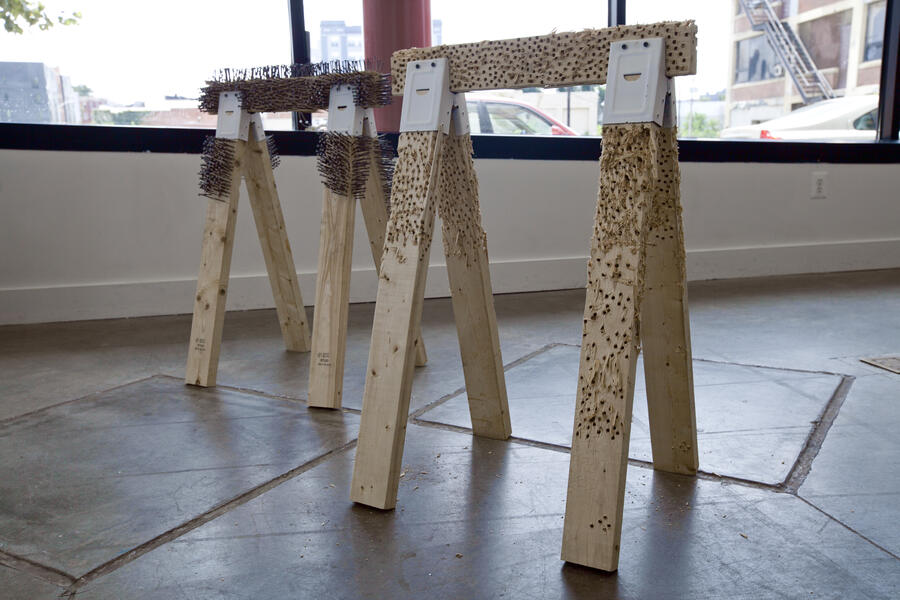 "Make Yourself Useful""Make Yourself Useful" uses utilitarian references of construction and carpentry to critique the woman's role as support structure, argue against gendered disciplines, and defunctunalizes the object as a gesture of protest. The sculpture consists of 2 2x4 lumber sawhorses, standard table height. The lumber of one sawhorse was drilled with 1/4" holes until it reached a point of near disintegration. The second sawhorse was nailed into until neither the lumber nor the sawhorse structure itself was able to support any kind of weight or platform. 2014
"Make Yourself Useful""Make Yourself Useful" uses utilitarian references of construction and carpentry to critique the woman's role as support structure, argue against gendered disciplines, and defunctunalizes the object as a gesture of protest. The sculpture consists of 2 2x4 lumber sawhorses, standard table height. The lumber of one sawhorse was drilled with 1/4" holes until it reached a point of near disintegration. The second sawhorse was nailed into until neither the lumber nor the sawhorse structure itself was able to support any kind of weight or platform. 2014 -
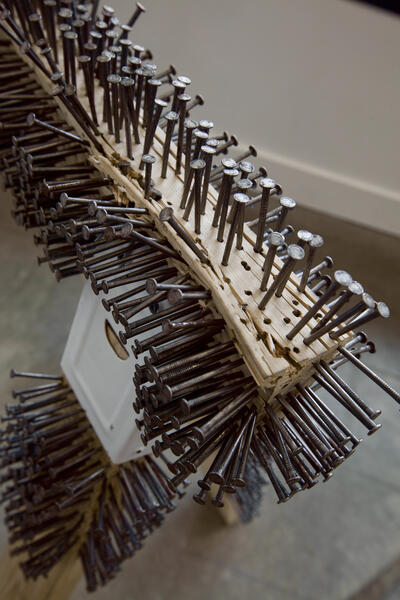 "Make Yourself Useful" DETAIL"Make Yourself Useful" uses utilitarian references of construction and carpentry to critique the woman's role as support structure, argue against gendered disciplines, and defunctunalizes the object as a gesture of protest. The sculpture consists of 2 2x4 lumber sawhorses, standard table height. The lumber of one sawhorse was drilled with 1/4" holes until it reached a point of near disintegration. The second sawhorse was nailed into until neither the lumber nor the sawhorse structure itself was able to support any kind of weight or platform. 2014
"Make Yourself Useful" DETAIL"Make Yourself Useful" uses utilitarian references of construction and carpentry to critique the woman's role as support structure, argue against gendered disciplines, and defunctunalizes the object as a gesture of protest. The sculpture consists of 2 2x4 lumber sawhorses, standard table height. The lumber of one sawhorse was drilled with 1/4" holes until it reached a point of near disintegration. The second sawhorse was nailed into until neither the lumber nor the sawhorse structure itself was able to support any kind of weight or platform. 2014 -
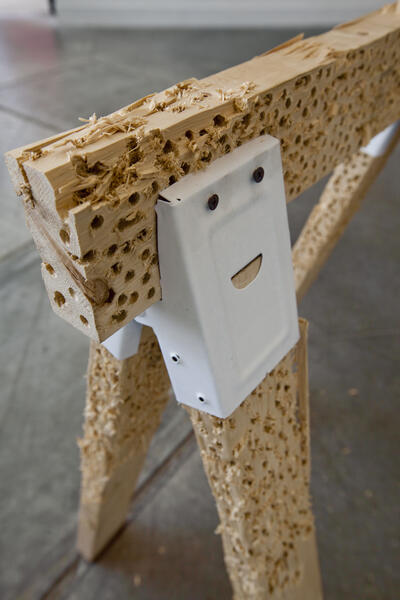 "Make Yourself Useful" DETAIL"Make Yourself Useful" uses utilitarian references of construction and carpentry to critique the woman's role as support structure, argue against gendered disciplines, and defunctunalizes the object as a gesture of protest. The sculpture consists of 2 2x4 lumber sawhorses, standard table height. The lumber of one sawhorse was drilled with 1/4" holes until it reached a point of near disintegration. The second sawhorse was nailed into until neither the lumber nor the sawhorse structure itself was able to support any kind of weight or platform. 2014
"Make Yourself Useful" DETAIL"Make Yourself Useful" uses utilitarian references of construction and carpentry to critique the woman's role as support structure, argue against gendered disciplines, and defunctunalizes the object as a gesture of protest. The sculpture consists of 2 2x4 lumber sawhorses, standard table height. The lumber of one sawhorse was drilled with 1/4" holes until it reached a point of near disintegration. The second sawhorse was nailed into until neither the lumber nor the sawhorse structure itself was able to support any kind of weight or platform. 2014 -
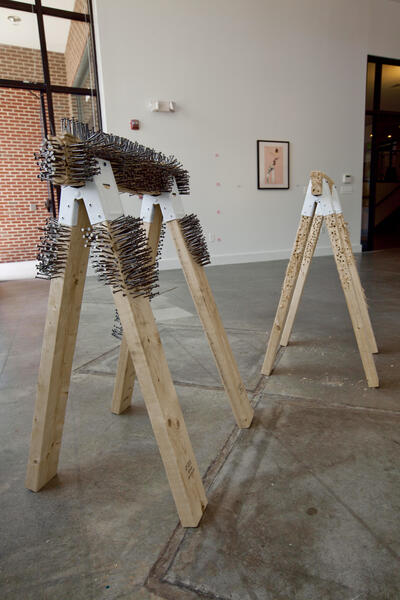 "Make Yourself Useful""Make Yourself Useful" uses utilitarian references of construction and carpentry to critique the woman's role as support structure, argue against gendered disciplines, and defunctunalizes the object as a gesture of protest. The sculpture consists of 2 2x4 lumber sawhorses, standard table height. The lumber of one sawhorse was drilled with 1/4" holes until it reached a point of near disintegration. The second sawhorse was nailed into until neither the lumber nor the sawhorse structure itself was able to support any kind of weight or platform. 2014
"Make Yourself Useful""Make Yourself Useful" uses utilitarian references of construction and carpentry to critique the woman's role as support structure, argue against gendered disciplines, and defunctunalizes the object as a gesture of protest. The sculpture consists of 2 2x4 lumber sawhorses, standard table height. The lumber of one sawhorse was drilled with 1/4" holes until it reached a point of near disintegration. The second sawhorse was nailed into until neither the lumber nor the sawhorse structure itself was able to support any kind of weight or platform. 2014 -
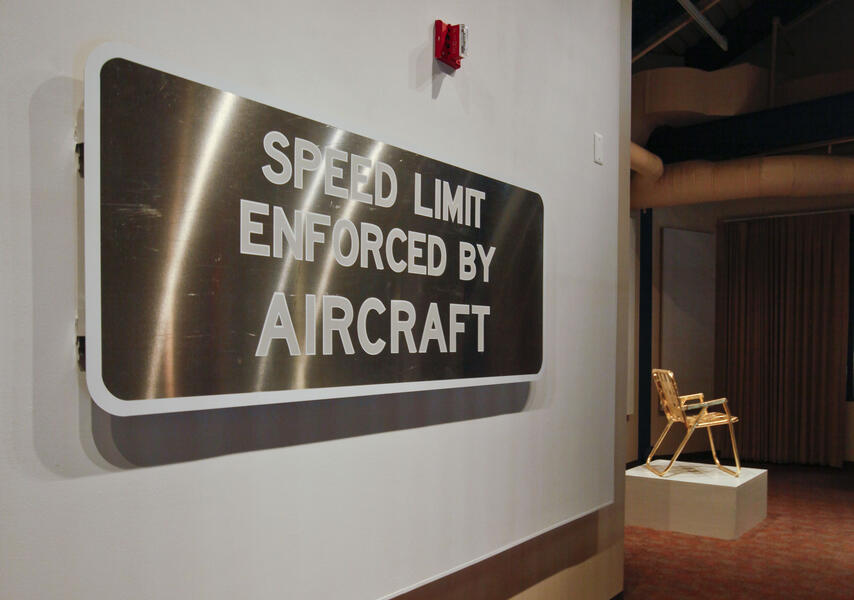 "Untitled (Monitored)Reflective Vinyl on Highway Grade Aluminum 2014
"Untitled (Monitored)Reflective Vinyl on Highway Grade Aluminum 2014 -
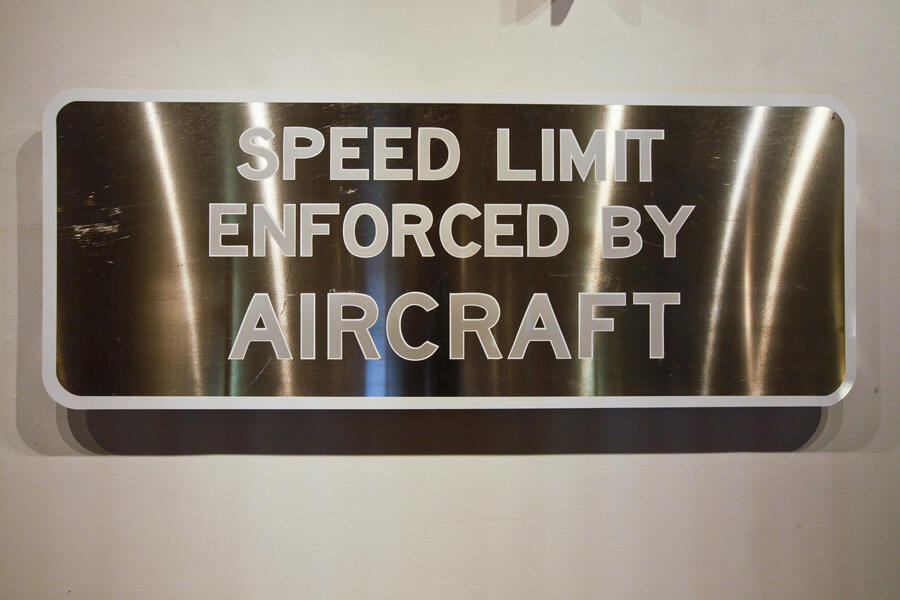 "Untitled (Monitored)"Reflective Vinyl on Highway Grade Aluminum
"Untitled (Monitored)"Reflective Vinyl on Highway Grade Aluminum -
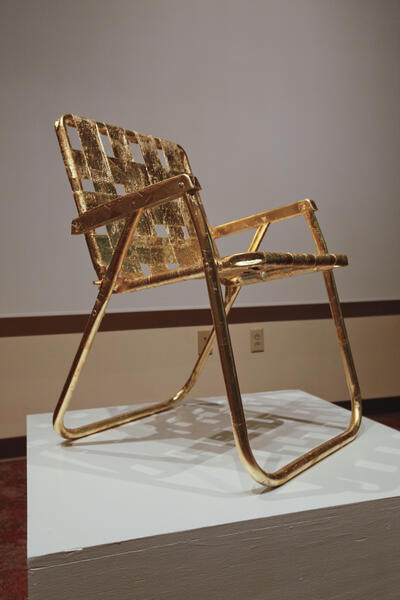 "Throne"Found Lawn Chair, Gold Leaf 2014
"Throne"Found Lawn Chair, Gold Leaf 2014 -
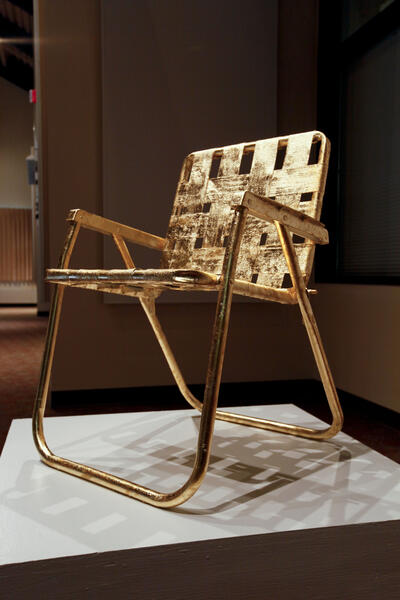 "Throne"Found Lawn Chair, Gold Leaf 2014
"Throne"Found Lawn Chair, Gold Leaf 2014
"Untitled Emergency Survival Tactics"
-
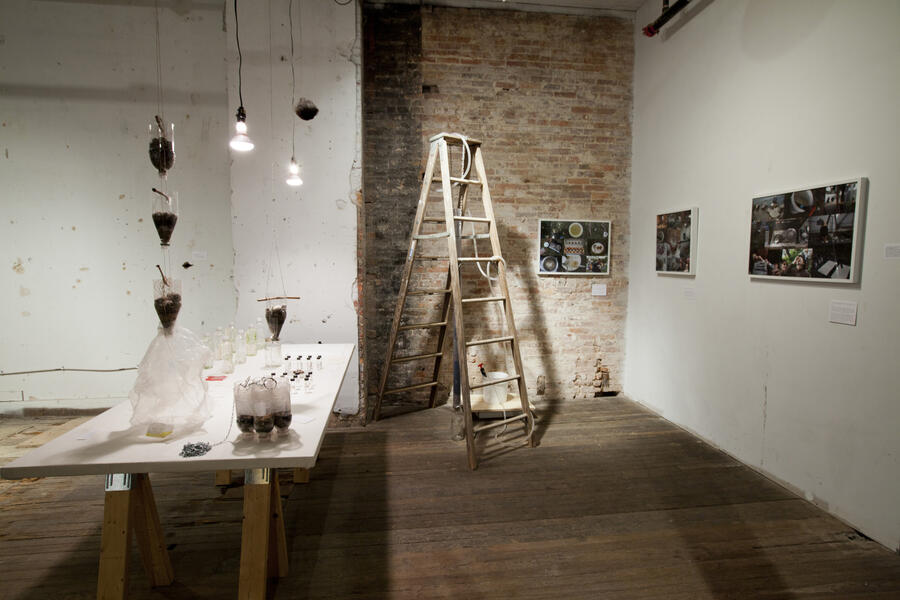 Emergency Survival Tactics, An Ongoing Study and Archive - Installation View"Emergency Survival Tactics, An Ongoing Study and Archive" was included in 2011 exhibition "Water Sonettos" curated by Jann Rosen-Queralt at In/Flux Gallery. For the exhibition, Glebes combined and presented 4 years of water experiments, research, and performance documentation from the Emergency Survival Tactics series.
Emergency Survival Tactics, An Ongoing Study and Archive - Installation View"Emergency Survival Tactics, An Ongoing Study and Archive" was included in 2011 exhibition "Water Sonettos" curated by Jann Rosen-Queralt at In/Flux Gallery. For the exhibition, Glebes combined and presented 4 years of water experiments, research, and performance documentation from the Emergency Survival Tactics series. -
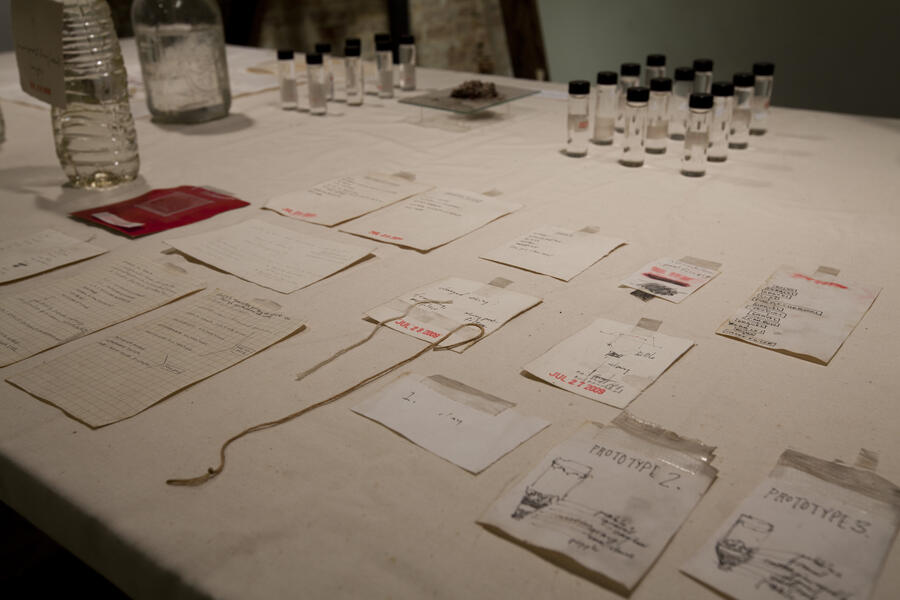 Emergency Survival Tactics, An Ongoing Study and Archive - Detail"Emergency Survival Tactics, An Ongoing Study and Archive" was included in 2011 exhibition "Water Sonettos" curated by Jann Rosen-Queralt at In/Flux Gallery. For the exhibition, Glebes combined and presented 4 years of water experiments, research, and performance documentation from the Emergency Survival Tactics series.
Emergency Survival Tactics, An Ongoing Study and Archive - Detail"Emergency Survival Tactics, An Ongoing Study and Archive" was included in 2011 exhibition "Water Sonettos" curated by Jann Rosen-Queralt at In/Flux Gallery. For the exhibition, Glebes combined and presented 4 years of water experiments, research, and performance documentation from the Emergency Survival Tactics series. -
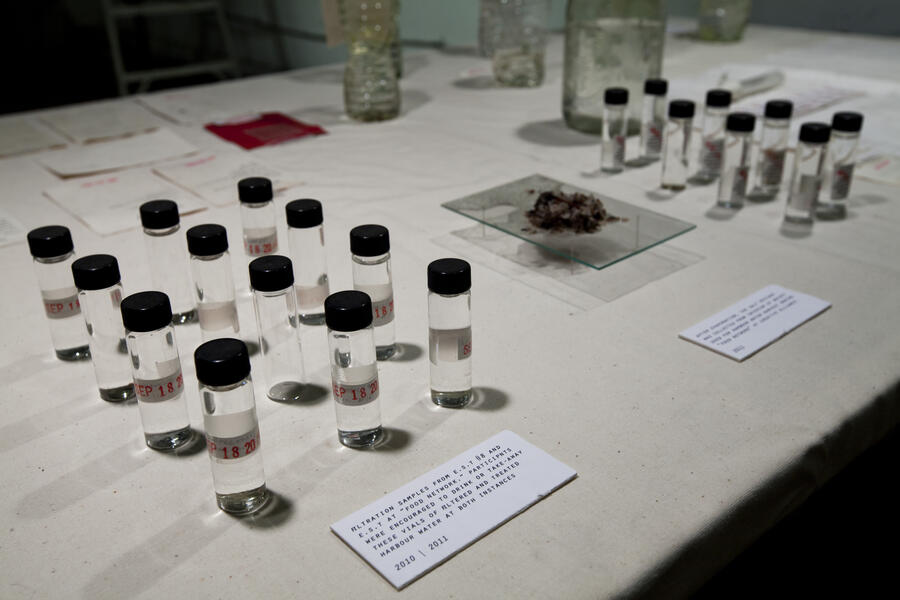 Emergency Survival Tactics, An Ongoing Study and Archive - Detail"Emergency Survival Tactics, An Ongoing Study and Archive" was included in 2011 exhibition "Water Sonettos" curated by Jann Rosen-Queralt at In/Flux Gallery. For the exhibition, Glebes combined and presented 4 years of water experiments, research, and performance documentation from the Emergency Survival Tactics series.
Emergency Survival Tactics, An Ongoing Study and Archive - Detail"Emergency Survival Tactics, An Ongoing Study and Archive" was included in 2011 exhibition "Water Sonettos" curated by Jann Rosen-Queralt at In/Flux Gallery. For the exhibition, Glebes combined and presented 4 years of water experiments, research, and performance documentation from the Emergency Survival Tactics series. -
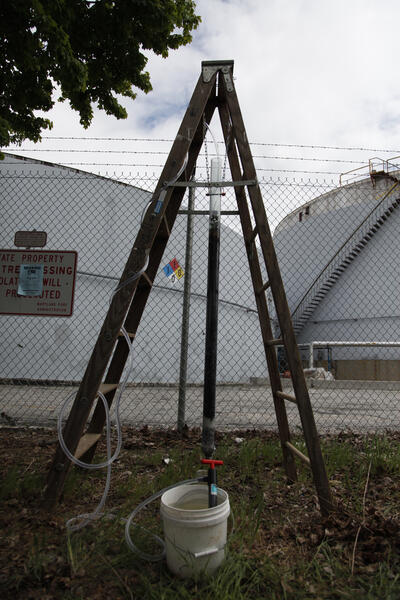 Untitled Emergency Survival Tactic #8 (expertise vs. dilettantism in potability, trust, and personal purity
Untitled Emergency Survival Tactic #8 (expertise vs. dilettantism in potability, trust, and personal purity2010
materials: harbour water, self-designed and built filter (clear pvc pipe, rocks, gravel, sand, plant, soil, cotton, activated carbon, water bottle), chain, ladder, champagne flutes, cook pot, propane stove, non-rigid pvc tubing, scintillation vials, bleach, syringes, paper, bucket, hand pump, audience participation project description: In this work, presented at the 2010 Transmodern Festivalâ??s Pedestrian Services Exquisite, Glebes filtered Baltimoreâ??s inner harbour water with a self-designed and constructed water filter, treated it for microbial and viral contamination using only water or bleach, then invited viewers to drink the water from champagne flutes or take away purified water in vials as a true souvenir of the city. A tally was kept of those who drank, and from which treatment process. ---thank you to jill fannon and fred scharmen for their photographs -
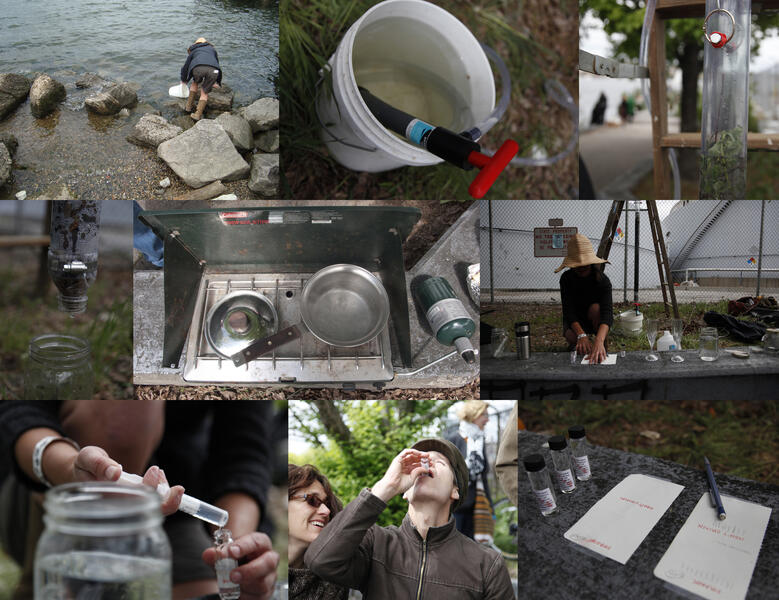 Untitled Emergency Survival Tactic #8 (expertise vs. dilettantism in potability, trust, and personal purity
Untitled Emergency Survival Tactic #8 (expertise vs. dilettantism in potability, trust, and personal purityDocumentation of performance and viewer participation.
2010
materials: harbour water, self-designed and built filter (clear pvc pipe, rocks, gravel, sand, plant, soil, cotton, activated carbon, water bottle), chain, ladder, champagne flutes, cook pot, propane stove, non-rigid pvc tubing, scintillation vials, bleach, syringes, paper, bucket, hand pump, audience participation project description: In this work, presented at the 2010 Transmodern Festivalâ??s Pedestrian Services Exquisite, Glebes filtered Baltimoreâ??s inner harbour water with a self-designed and constructed water filter, treated it for microbial and viral contamination using only water or bleach, then invited viewers to drink the water from champagne flutes or take away purified water in vials as a true souvenir of the city. A tally was kept of those who drank, and from which treatment process. ---thank you to jill fannon and fred scharmen for their photographs -
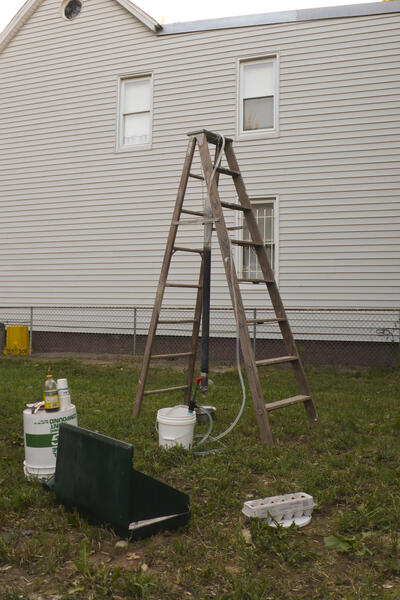 Untitled Emergency Survival Tactic #12 (Poached Eggs from the Jones Falls River)materials: Jones Falls River water, self-designed and built filter (clear pvc pipe, rocks, gravel, sand, sedum, soil, cotton, activated carbon, water bottle), chain, ladder, dixie cups, cook pot, non-rigid pvc tubing, local eggs, apple cider vinegar, slotted spoon, bucket, hand pump. audience participation project description: In this work, presented at the first Mobile Market of the Food Network exhibition at the Creative Alliance, Glebes collected water from the Jones Falls River, filtered it through a self-designed and hand-built filter, then boiled it to not only kill microbial contaminants, but also to cook poached eggs. The eggs were prepared and served for consumption by willing participants at their request under full disclosure of the process.
Untitled Emergency Survival Tactic #12 (Poached Eggs from the Jones Falls River)materials: Jones Falls River water, self-designed and built filter (clear pvc pipe, rocks, gravel, sand, sedum, soil, cotton, activated carbon, water bottle), chain, ladder, dixie cups, cook pot, non-rigid pvc tubing, local eggs, apple cider vinegar, slotted spoon, bucket, hand pump. audience participation project description: In this work, presented at the first Mobile Market of the Food Network exhibition at the Creative Alliance, Glebes collected water from the Jones Falls River, filtered it through a self-designed and hand-built filter, then boiled it to not only kill microbial contaminants, but also to cook poached eggs. The eggs were prepared and served for consumption by willing participants at their request under full disclosure of the process. -
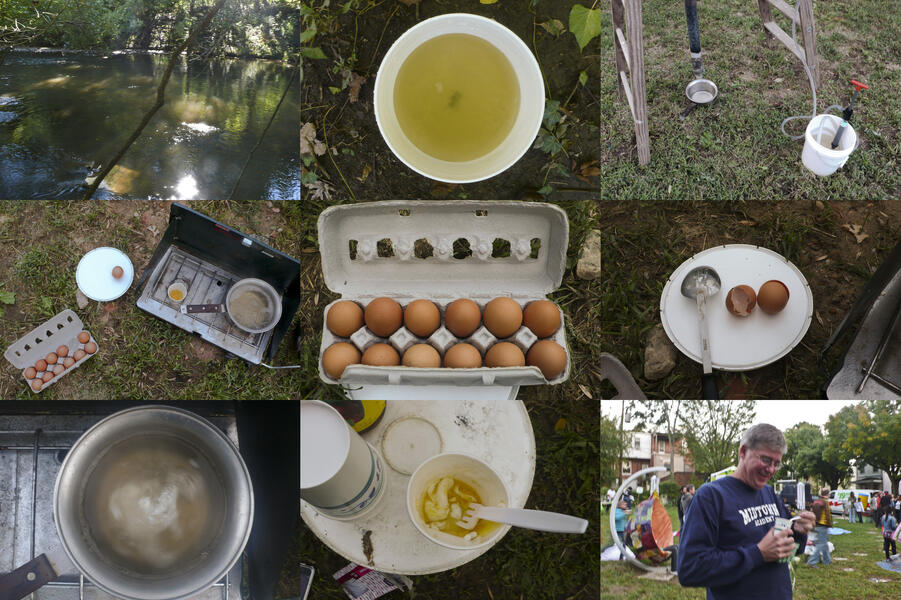 Untitled Emergency Survival Tactic #12 (Poached Eggs from the Jones Falls River)materials: Jones Falls River water, self-designed and built filter (clear pvc pipe, rocks, gravel, sand, sedum, soil, cotton, activated carbon, water bottle), chain, ladder, dixie cups, cook pot, non-rigid pvc tubing, local eggs, apple cider vinegar, slotted spoon, bucket, hand pump. audience participation project description: In this work, presented at the first Mobile Market of the Food Network exhibition at the Creative Alliance, Glebes collected water from the Jones Falls River, filtered it through a self-designed and hand-built filter, then boiled it to not only kill microbial contaminants, but also to cook poached eggs. The eggs were prepared and served for consumption by willing participants at their request under full disclosure of the process.
Untitled Emergency Survival Tactic #12 (Poached Eggs from the Jones Falls River)materials: Jones Falls River water, self-designed and built filter (clear pvc pipe, rocks, gravel, sand, sedum, soil, cotton, activated carbon, water bottle), chain, ladder, dixie cups, cook pot, non-rigid pvc tubing, local eggs, apple cider vinegar, slotted spoon, bucket, hand pump. audience participation project description: In this work, presented at the first Mobile Market of the Food Network exhibition at the Creative Alliance, Glebes collected water from the Jones Falls River, filtered it through a self-designed and hand-built filter, then boiled it to not only kill microbial contaminants, but also to cook poached eggs. The eggs were prepared and served for consumption by willing participants at their request under full disclosure of the process. -
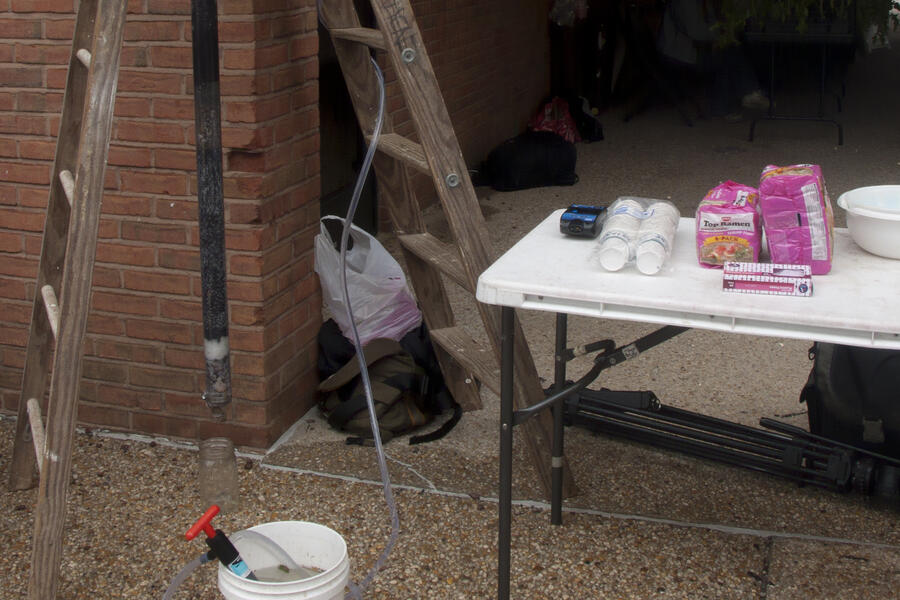 Untitled Emergency Survival Tactic #10 (Ramen Made From the Pond Water for the College Survivalist)
Untitled Emergency Survival Tactic #10 (Ramen Made From the Pond Water for the College Survivalist)project description: In â??Ramen from Pond Water,â? A battery was charged by riding stationary bicycles in the gallery. The battery was then transported to the outdoors where Glebes filtered then, using an electric kettle powered by the battery, boiled water collected from the stormwater retention pond at the heart of a college campus during lunch hour, then used the boiled water to make ramen noodles, which were fed to students under full disclosure of the process. This work was executed in collaboration with Jaimes Mayhew for inclusion in the CADVCâ??s IMDA MFA Exhibition.
-
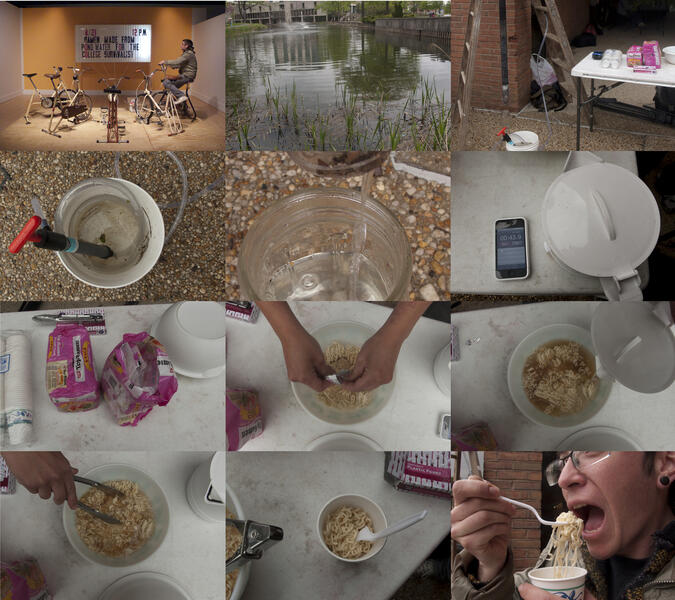 Untitled Emergency Survival Tactic #10 (Ramen Made From the Pond Water for the College Survivalist)
Untitled Emergency Survival Tactic #10 (Ramen Made From the Pond Water for the College Survivalist)2010
materials: pond water from UMBC stormwater retention pond, self-designed and built filter (clear pvc pipe, rocks, gravel, sand, plant, soil, cotton, activated carbon, water bottle), chain, ladder, Top Ramen, table, non-rigid pvc tubing, bucket, hand pump, tongs, electric kettle, portable battery, audience participation
project description: In â??Ramen from Pond Water,â? A battery was charged by riding stationary bicycles in the gallery. The battery was then transported to the outdoors where Glebes filtered then, using an electric kettle powered by the battery, boiled water collected from the stormwater retention pond at the heart of a college campus during lunch hour, then used the boiled water to make ramen noodles, which were fed to students under full disclosure of the process. This work was executed in collaboration with Jaimes Mayhew for inclusion in the CADVCâ??s IMDA MFA Exhibition.
-
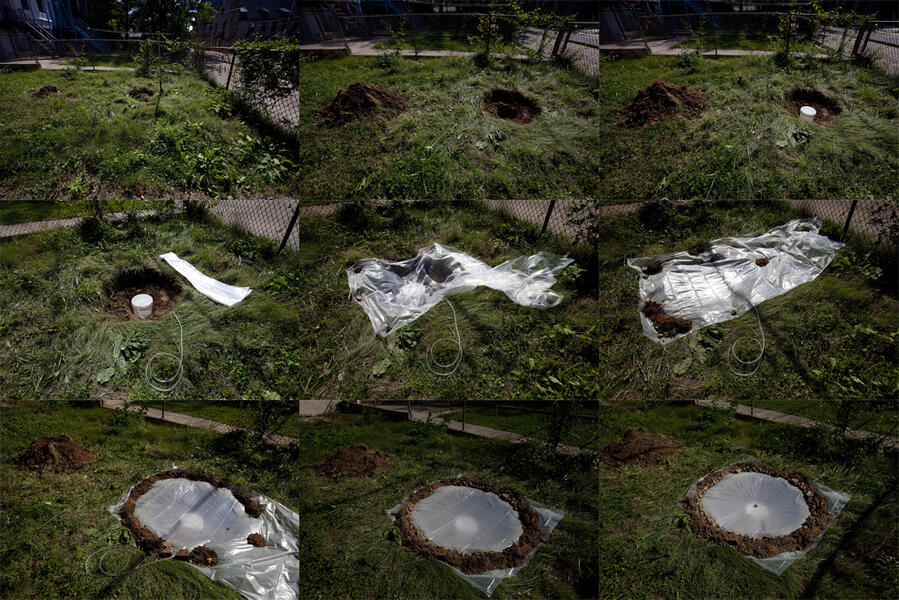 Untitled Emergency Survival Tactic #6 (Solar Still)
Untitled Emergency Survival Tactic #6 (Solar Still)2009
materials: plastic tarp, vacant lot, bucket, non-rigid pvc tubing, rubble
project description: In (Solar Still), Glebes assembled a solar still based on wilderness-survival techniques in a derelict yard as part of the Fall 2009 Axis Alley exhibition. Potable water condensed on the plastic tarp covering the large hole dug in the ground, then drained into a bucket at the center of the hole, and was pumped out via the tubing.
"campcamp" and "National Park(ing)"
National Park(ing) was installed for Artscape 2012 in the parking garage across from the Charles Theatre. Four landscapes were temporarily installed on the street, inviting visitors inside to a climbing mountain, visitor center, library, and lounge area. This project was executed in collaboration with C. Ryan Patterson, Fred Scharmen, and Rachel Valsing.
-
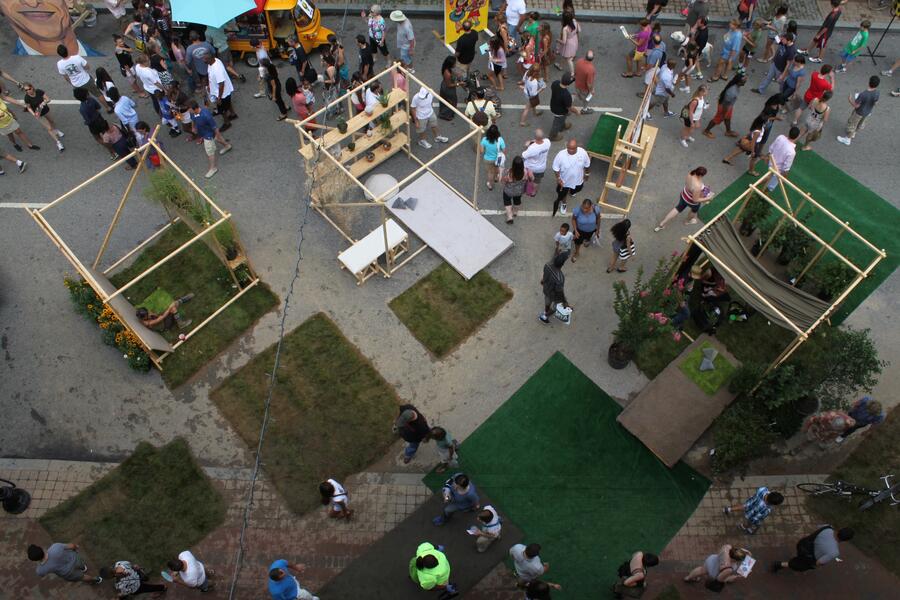 National Park(ing)
National Park(ing) -
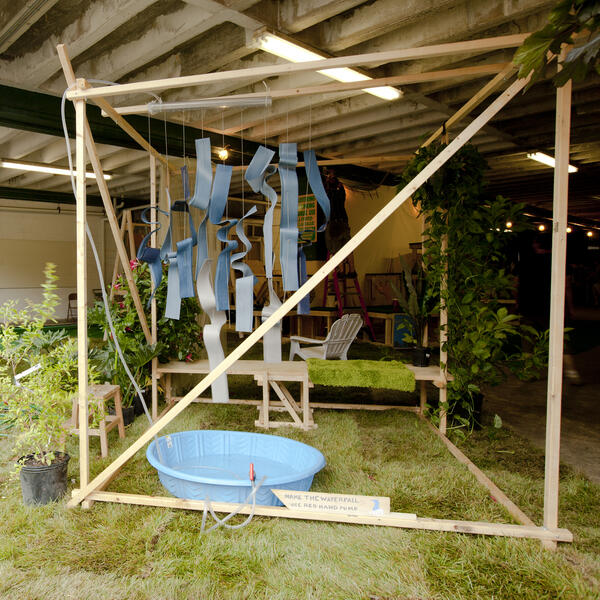 National Park(ing): Tropical Forest Cube
National Park(ing): Tropical Forest Cube -
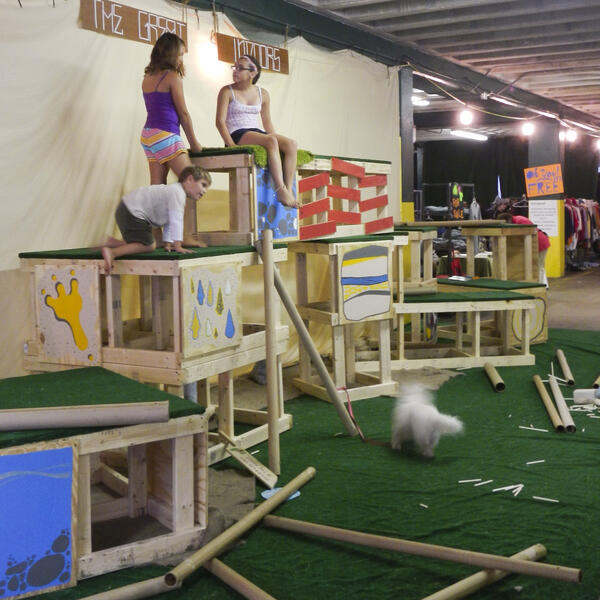 National Park(ing): Great Indoors Mountain
National Park(ing): Great Indoors Mountain -
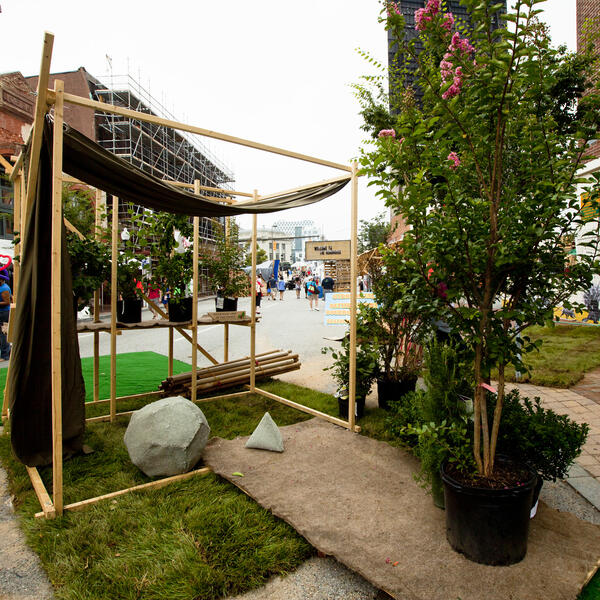 National Park(ing): Deciduous Forest Cube
National Park(ing): Deciduous Forest Cube -
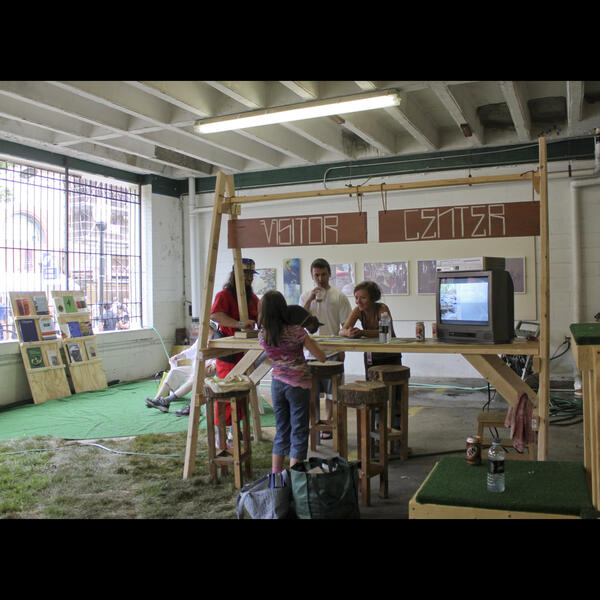 National Park(ing): Visitor Center
National Park(ing): Visitor Center -
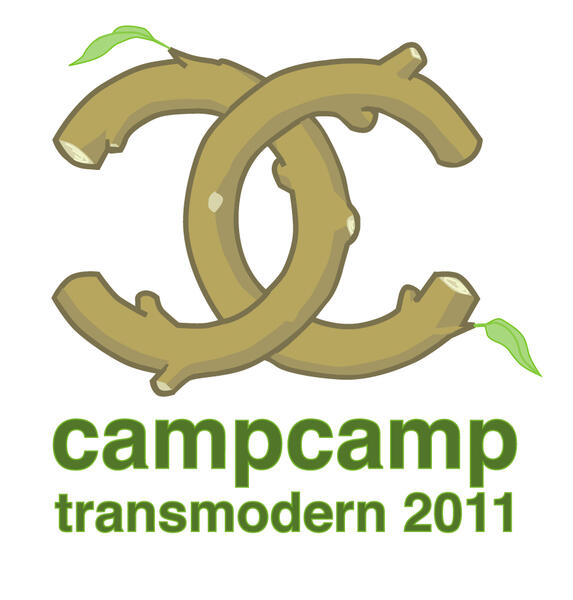 campcamp Logo
campcamp Logo -
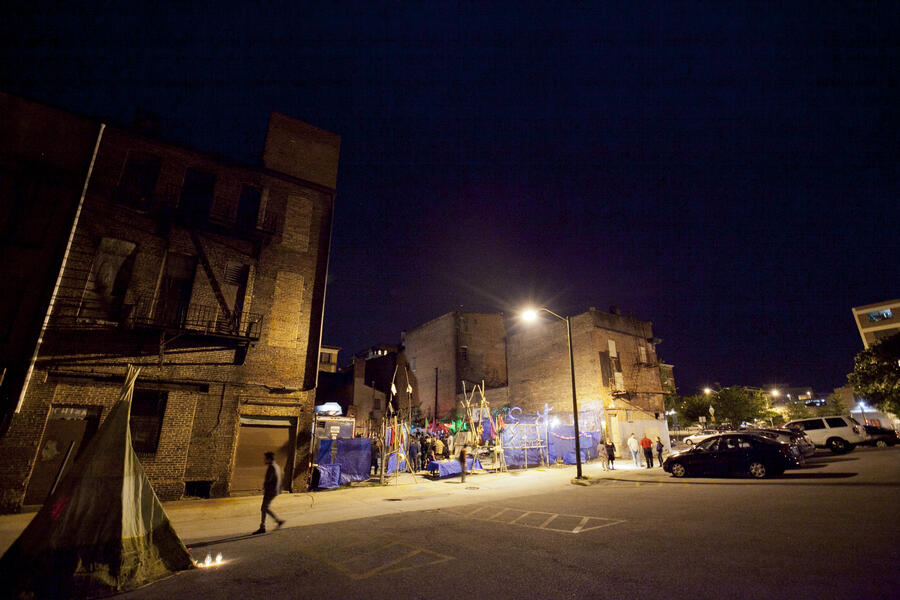 campcamp Exterior View
campcamp Exterior View -
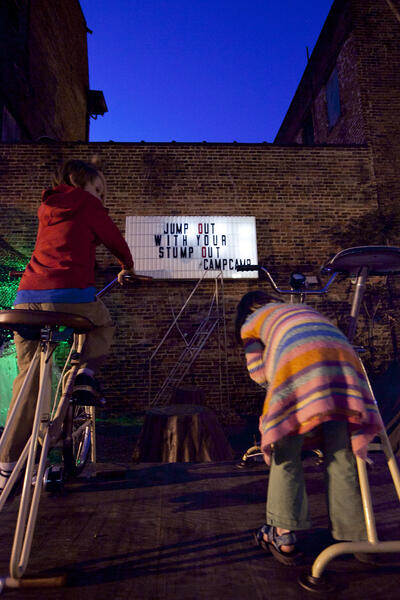 campcamp DETAILParticipants pedaled bicycles to power a light-up marquee in a campcamp installation by Jaimes Mayhew.
campcamp DETAILParticipants pedaled bicycles to power a light-up marquee in a campcamp installation by Jaimes Mayhew. -
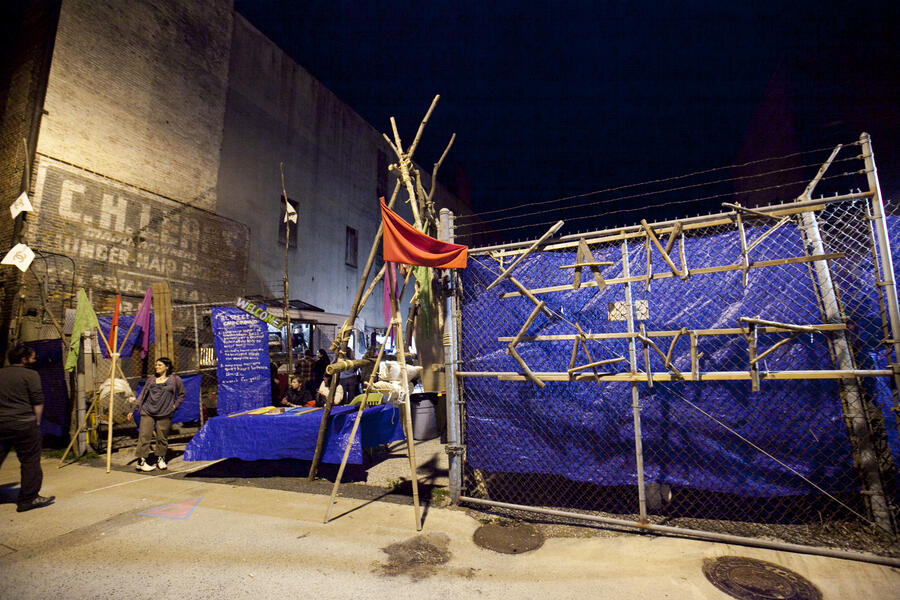 campcamp Intake Gateway
campcamp Intake Gateway -
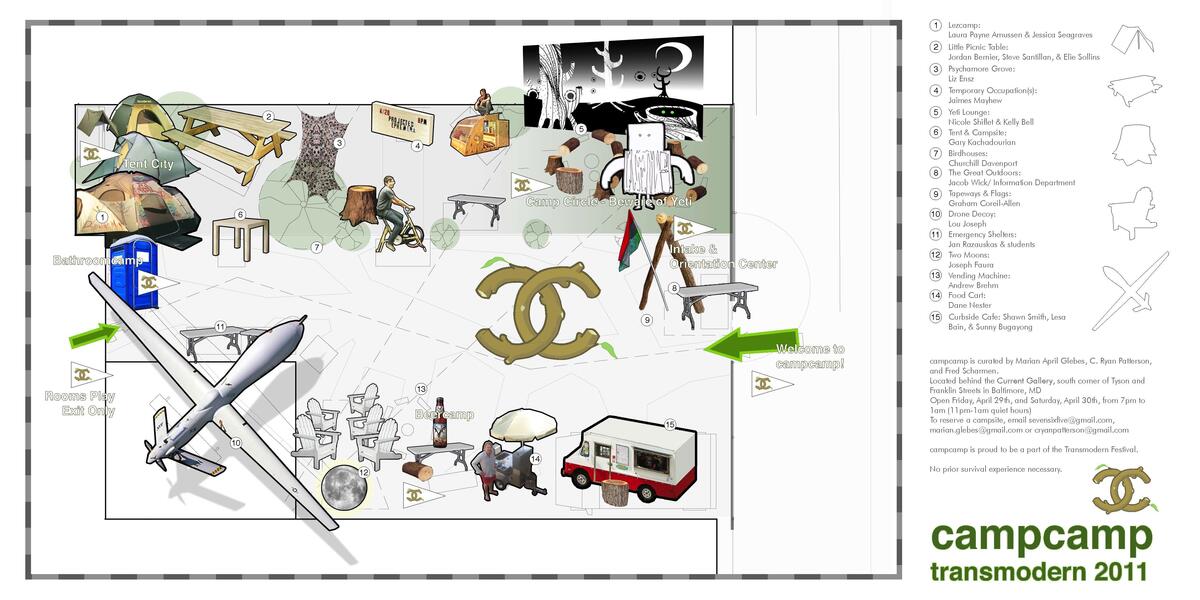 campcamp Site Map
campcamp Site Map



























































































